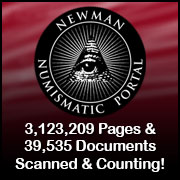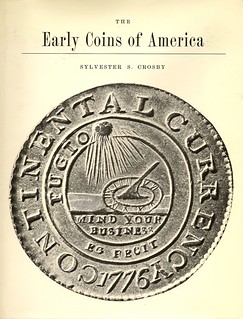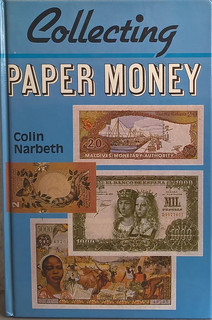
About UsThe Numismatic Bibliomania Society is a non-profit association devoted to the study and enjoyment of numismatic literature. For more information please see our web site at coinbooks.org SubscriptionsThose wishing to become new E-Sylum subscribers (or wishing to Unsubscribe) can go to the following web page link MembershipThere is a membership application available on the web site Membership Application To join, print the application and return it with your check to the address printed on the application. Print/Digital membership is $40 to addresses in the U.S., and $60 elsewhere. A digital-only membership is available for $25. For those without web access, write to: Charles Heck, Treasurer
AsylumFor Asylum mailing address changes and other membership questions, contact Chuck at this email address: treasurer@coinbooks.org SubmissionsTo submit items for publication in The E-Sylum, write to the Editor at this address: whomren@gmail.com BUY THE BOOK BEFORE THE COINSale Calendar |
- WAYNE'S WORDS: THE E-SYLUM MAY 20, 2020
- ASYLUM SUMMER 2020 ISSUE PUBLISHED
- MORE KOLBE & FANNING SALE 156 HIGHLIGHTS
- RARE BOOKS & FINE ARTS JULY 2020 LITERATURE SALE
- NEW BOOK: IRON AGE AND ROMAN COIN HOARDS
- NEW BOOK: RIVALLING ROME: PARTHIAN COINS
- NEW BOOK: TRAGEDIES IN ROMAN EUROPE
- NEW BOOK: LES ALEXANDRES APRÈS ALEXANDRE
- BOOK REVIEW: PAST & NEARLY PERFECT
- VIDEO: FINANCE MUSEUM OUT OF THE VAULT
- NEWMAN PORTAL DIGITIZES NUMISMATIC NEWS
- NNP ADDS SCRIPOPHILY AUCTION SALE CATALOG
- VIDEO: INTERVIEW WITH ROBERT HENDERSHOTT
- AUDIO: PIERRE FRICKE ON CONFEDERATE PAPER MONEY
- DRS. RUSH AND STEPHEN GIRARD VS. YELLOW FEVER
- CORONAVIRUS UPDATES: MAY 17, 2020
- MORE ON STACK'S FIXED PRICED LISTS
- MORE ON GLENN SMEDLEY
- NOTES FROM E-SYLUM READERS: MAY 17, 2020
- PETE SMITH'S ART GALLERY
- APPROVED GRADERS ON EBAY
- SURVEY: COLLECTING PREFERENCES
- VOCABULARY TERM: MARRIAGE MEDAL
- ROBERT SAVAGE (1868-1943)
- ROBERT WALLACE MCLACHLAN (1845-1926)
- ROBB REPORT INTERVIEWS DWIGHT MANLEY
- DONNA FRATER EXPANDS ANA ROLE
- ANA RACHEL CARSON 129TH CONVENTION MEDAL
- ON USING NON-NUMISMATIC RESOURCES
- DANIEL FRANK SEDWICK AUCTION 27
- STEPHEN ALBUM RARE COINS AUCTION 37
- WAYNE'S NUMISMATIC DIARY MAY 17, 2020
- NUMISMATIC NUGGETS: MAY 17, 2020
- YEAR TWO BAR KOKHBA REVOLT COIN FOUND
- ADAMS FAMILY TETRADRACHM OF NERO AND POPPAEA
- BROWNING PLATE 1823/2 QUARTER OFFERED
- EARLY COPPER COINAGE OF LIBERIA
- SILVER DOLLARS IN NEVADA CASINOS
- MALTA'S ILLUMINATED LETTER COINS
- HORSERACING TICKETS AND PASSES
- PENTAGON HOARD $20 MISMATCHED SERIAL NUMBERS
- WHAT IF PALESTINE HAD ITS OWN CURRENCY?
- LOOSE CHANGE: MAY 17, 2020
- ROYAL MINT COIN SCULPTURES
Click here to access the complete archive
To comment or submit articles, reply to whomren@gmail.com
Content presented in The E-Sylum is not necessarily researched or independently fact-checked, and views expressed do not necessarily represent those of the Numismatic Bibliomania Society.
WAYNE'S WORDS: THE E-SYLUM MAY 20, 2020
 This week we open with a new issue of our print journal The Asylum, two numismatic literature sales, four new books, a book review and updates from the Newman Numismatic Portal.
This week we open with a new issue of our print journal The Asylum, two numismatic literature sales, four new books, a book review and updates from the Newman Numismatic Portal.
Other topics this week include the Museum of American Finance, Bob Hendershott, Glenn Smedley, Robert McLachlan, Dwight Manley, Don Taxay, Henry Pickles, ebay rules, marriage medals, the Browning plate 1823/2 quarter, the copper coinage of Liberia, mismatched serial numbers and paper money designs for Palestine.
To learn more about the Martin Folkes collection, Dye's Bank Note Plate Delineator, Canadian Large Cent patterns, scripophily, coronavirus updates, auction previews, the Adams family tetradrachm, the ANA Rachel Carson medal, the "Woe is me" medal, the largest book ever published, and Dennis Rodman's numismatic connection, read on. Have a great week, everyone!
Wayne Homren
Editor, The E-Sylum
ASYLUM SUMMER 2020 ISSUE PUBLISHED
Maria Fanning edits our print journal The Asylum, and she reports that the latest issue is on the way and also available online. -Editor
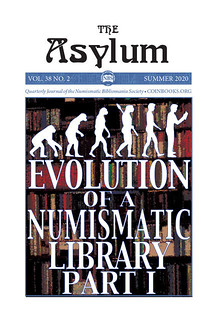 The Asylum
The Asylum
Summer 2020
Volume 38 Number 2
The Asylum Special Issue: "Evolution of a Numismatic Library"
The Asylum's Summer 2020 Special Issue, "Evolution of a Numismatic Library, Part 1" is on its way to NBS members and it's a great one! I'm glad to see that everyone is taking advantage of our extended time at home enjoying their
numismatic libraries. We had so many great submissions on this theme that we decided to break them into two issues. The second part will be our Fall issue, due out in September after the ANA's World's Fair of Money, scheduled to take place
in Pittsburgh this year.
Free Issue of The Asylum
To help all numismatic bibliophiles through this stressful time, we are offering this issue free to everyone. Please download your copy of this special theme issue at coinbooks.org and share our love of
numismatic literature.
To join NBS or renew your membership, see:
https://www.coinbooks.org/about/membership.html
MORE KOLBE & FANNING SALE 156 HIGHLIGHTS
Kolbe & Fanning's next numismatic literature sale will close May 30, 2020. Here are some more highlights. -Editor
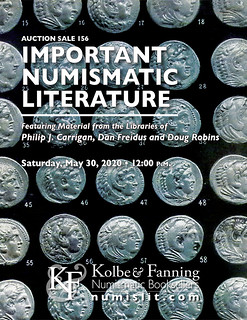 Kolbe & Fanning Numismatic Booksellers will be conducting our 156th auction on Saturday, May 30, 2020. The 419-lot sale includes a remarkable selection of books on ancient, world and U.S.
numismatics, including material from the libraries of Phil Carrigan, Dan Freidus, and Doug Robins. The sale features an especially diverse selection of material, perhaps most notable for rare and unusual American publications, but also including a
number of infrequently encountered and desirable works on ancient and foreign coins and medals.
Kolbe & Fanning Numismatic Booksellers will be conducting our 156th auction on Saturday, May 30, 2020. The 419-lot sale includes a remarkable selection of books on ancient, world and U.S.
numismatics, including material from the libraries of Phil Carrigan, Dan Freidus, and Doug Robins. The sale features an especially diverse selection of material, perhaps most notable for rare and unusual American publications, but also including a
number of infrequently encountered and desirable works on ancient and foreign coins and medals.
Some highlights of the sale include:
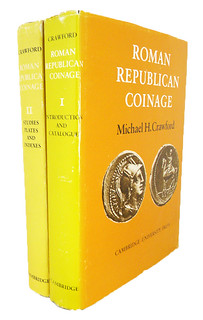
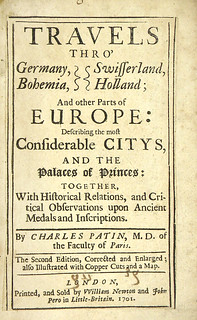
Lots 15 and 45
Lot 15: a first edition set of Crawford on Roman Republican coins
Lot 45: an unlisted 1701 London edition of Charles Patin's Travels ... with Historical Relations, and Critical Observations upon Ancient Medals and Inscriptions
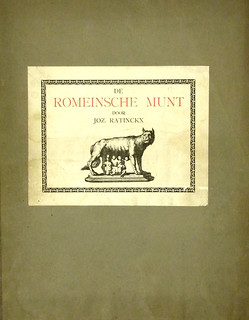
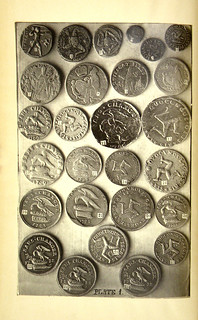
Lots 48 and 89
Lot 48: Ratinckx's rare 1920 work on the art of Roman coins, De Romeinsche Munt Beschouwd als Kunstvoortbrengsel
Lot 89: Clay's classic 1869 study of the Manx coinage, with four photographic plates
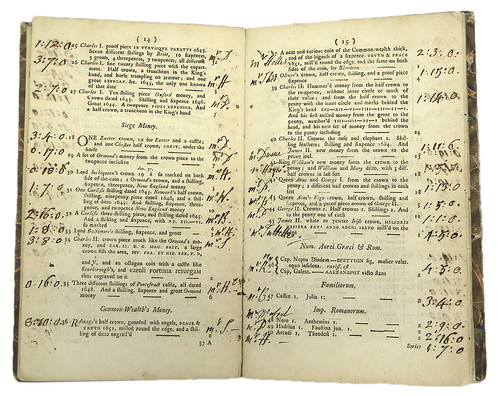
Lot 124
Lot 124: Eric P. Newman's copy of the rare 1756 sale of the Martin Folkes collection, priced and named
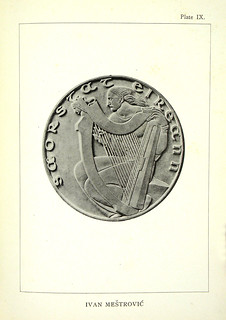
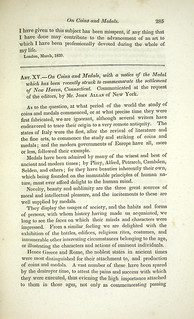
Lots 171 and 179
Lot 171: the historic Coinage of Saorstát Éireann, recording the Irish Free State's first coinage, compiled by a committee chaired by poet W.B. Yeats
Lot 179: a rare early American article by John Allan on coins and medals, unlisted in Attinelli and one of the earliest such works
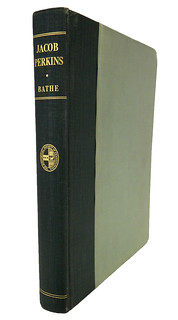
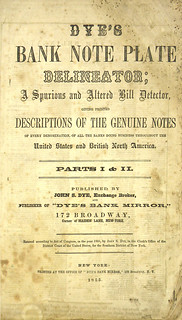
Lots 208 and 262
Lot 208: the outstanding Jacob Perkins: His Inventions, His Times, and His Contemporaries, by Greville & Dorothy Bathe, one of only 200 copies printed
Lot 262: the extremely rare first printing of Dye's 1855 Bank Note Plate Delineator, designated on the title page as Parts I & II, and the only copy known to us in private hands
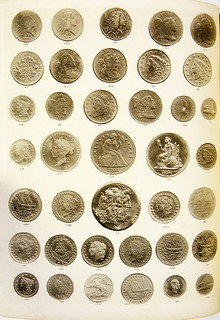 Lot 263: Tom Elder's own copy of his first plated auction catalogue, featuring selections from the collection of J.N.T. Levick et al.
Lot 263: Tom Elder's own copy of his first plated auction catalogue, featuring selections from the collection of J.N.T. Levick et al.
The printed catalogue has been mailed to active customers. As international mail speeds have been slowed by the Corona situation, we are asking our international clients to rely upon the electronic catalogue, though we will be happy to provide printed copies upon request.
A PDF of the printed catalogue has been posted to our main website at numislit.com for those who prefer that format. Bids placed via post, email, fax or phone must be received by Friday, May 29, the day before the sale, in order for them to be processed. Advance absentee bids may also be placed at any time online at bid.numislit.com; live internet bidding will be available during the sale itself through the same platform.
Kolbe & Fanning Numismatic Booksellers LLC is a licensed and bonded auction firm in the State of Ohio. For more information, please see the Kolbe & Fanning website at bid.numislit.com or email David Fanning at df@numislit.com.
To bid and view lots, see:
https://bid.numislit.com/
To read the earlier E-Sylum article, see:
KOLBE & FANNING SALE 156 ANNOUNCED (https://www.coinbooks.org/v23/esylum_v23n19a02.html)
RARE BOOKS & FINE ARTS JULY 2020 LITERATURE SALE
Dr. Riccardo Paolucci of numismatic booksellers Rare Books & Fine Arts Ltd of London writes:
"We are announcing our Sale 5, which will be held on Sunday, July 5, 2020. The 105-lot sale includes a remarkable selection of books on ancient and world numismatics."
Here are some selected lots. -Editor
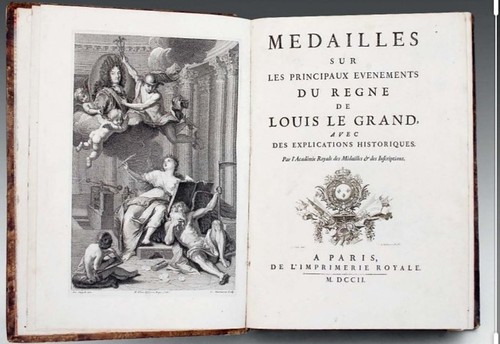
Lot 3: ANONYMOUS. Medailles sur les principaux evenements du regne de Louis Le Grand, avec des explications historiques. A Paris, De l'Imprimerie Royale, 1702 cm. 28,5, cc. 292. With 286 engraved figures of medals. Coeval binding in full leather, nerve back with gold titles and decorations. Specimen with some defects and peeling on the binding, some internal browning, overall good conservation. First RARE edition
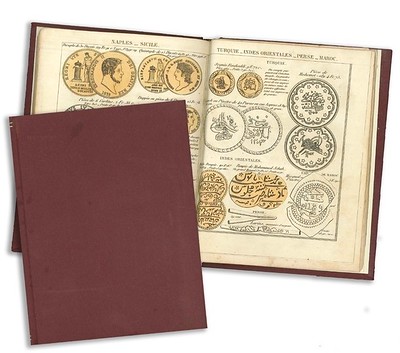
Lot 5: ANONYMOUS. Tableau des monnaies d'or et d'argent des principaux ètats du monde. Paris, Lefèvre, s.a. (1880 ca.) Coeval binding in full dry-decorated red canvas and with gold titles on the back. Cm. 17,5, pp. 72. With 30 beautiful tables f.t. in chromolithography depicting many species of coins. A small gap in the back, however well preserved.
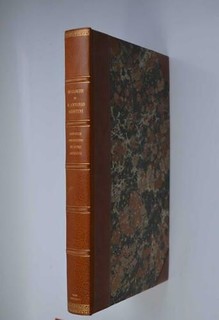
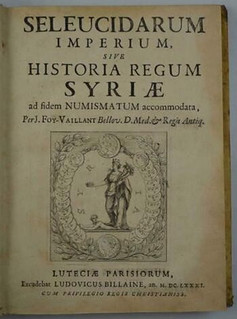
Lot 7: AGOSTINI ANTONIO. Dialoghi... sopra le medaglie, inscrizzioni, ed altre antichità tradotti dalla Lingua Spagnuola nell'Italiana da Dionigi Ottaviano Sada e dal medesimo accresciuti con diverse Annotazioni Istoriche, e nuovamente illustrati con molte medaglie...In Roma, per Girolamo Mainardi, 1736 cm. 35, pp. (24) xxx (2) 318 (6). Frontispiece in red and black with central vignette engraved in copper. With hundreds of wood engravings in the text. On the front of the last card, engraving of "Measure of the Ancient Medals Carved in Gold, Silver & Copper, & more, found by Dionysius Ottaviano Sada". Recent amateurs binding in half leather with spikes, nerve back with gold titles and threads. Within custody. Marginal and well preserved specimen. The work is preceded by a Latin ode by Giuseppe Castiglione and a short life by Agostini taken from the funeral oration in his honor by the Jesuit Andrea Scotti. Valuable eighteenth-century edition of this numismatic and archaeological treatment in dialogical form, in the classic version of the Sada, also remarkable for its illustrative richness (in addition to the medals, arches, monuments, Roman inscriptions are reproduced).
The original edition is from 1587; the original of the Sada version of 1650, with the addition of a twelfth dialogue, composed by the Jesuit Andrea Scotti. Agostini (Zaragoza, 1517-1586), bishop of Tarragona, long residing in Italy, was a jurist, latinist and scholar of antiquity capable of interdisciplinarily combining the most varied branches of knowledge, as well as in this work pioneer of the studies of medals. Doctor of law and author of fundamental Roman and canon law studies, he was the auditor of Rota in Rome on the proposal of Charles V, papal ambassador to England, sent to Vienna to negotiate peace between Philip II of Spain and Ferdinand I of Austria. Bishop of Alife, Lerida and Tarragona, he took part in the Tridentine Council, carrying out diplomatic assignments which earned him diplomatic renown no less than for his scholarly activity. See Cicognara, 2728; Brunet, I, 568; Scandalized Ciciani, "La Letteratura Numismatica", n. 41; Graesse, I, 253. VERY RARE
Lot 32: FOY VAILLANT Jena. Seleucidarum imperium, sive historia regum Syriae ad fidem numismatum accomodata. Luteciae Parisorum, Ludovicus Billaine, 1681 cm. 23,5, pp. (24) 463 (1). Large engraving on the title page, headboards, drop cap and many figures of coins in the text. Solid eighteenth-century binding in full rigid parchment with passing nerves and gold titles on a two-tone double gusset. Some light scattered burnishing, however genuine and in excellent condition. VERY RARE original and unique edition of this work by the scholar and adventurer Vaillant. The latter helped to study and perhaps even more to plunder the Middle Eastern territories, contributing to embellishing the numismatic collections of the Parisian Cabinet des médailles.
To read the complete lot listings, see:
RARE BOOKS & FINE ARTS E-Auction 5 Numismatic Literature and Coins (https://www.biddr.com/auctions/rarebooksandfinearts/browse?a=1114)
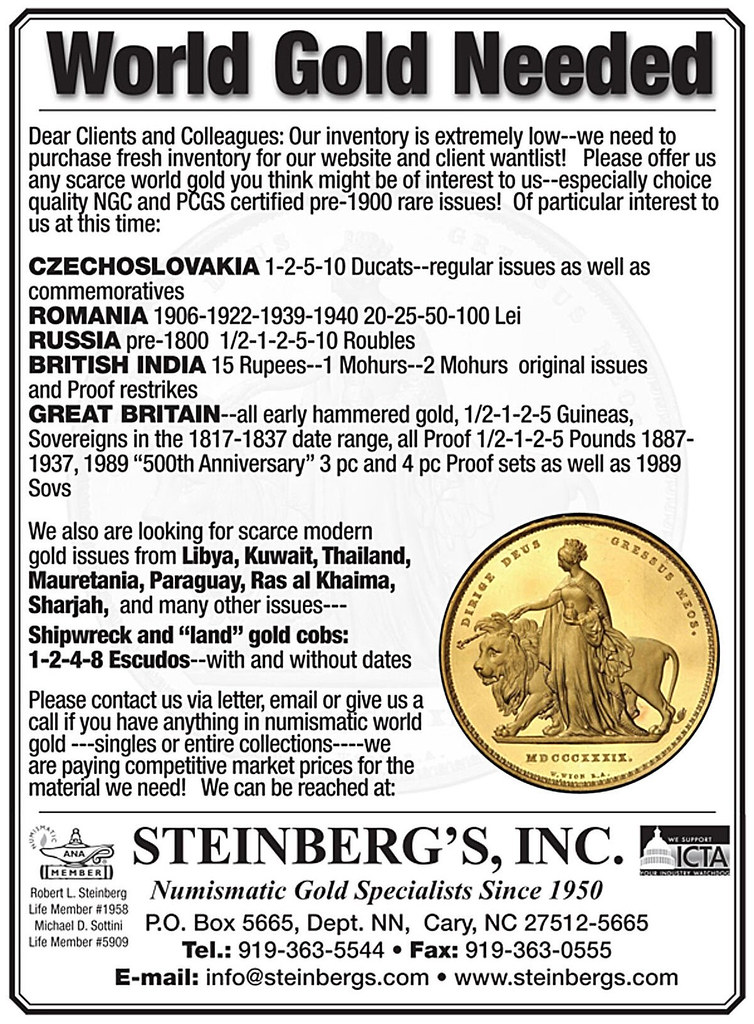
NEW BOOK: IRON AGE AND ROMAN COIN HOARDS
SPINK is offering a new book on Iron Age and Roman Coin Hoards in Britain. -Editor
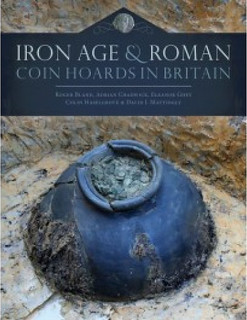 Iron Age and Roman Coin Hoards in Britain
Iron Age and Roman Coin Hoards in Britain
by Roger Bland, Adrian Chadwick, Eleanor Ghey, Colin Haselgrove and David J Mattingly
Product Code:5249
Availability:In Stock
£65.00
Hardback
ISBN: 9781785708558
More coin hoards have been recorded from Roman Britain than from any other province of the Empire. This comprehensive and lavishly illustrated volume provides a survey of over 3260 hoards of Iron Age and Roman coins found in England and Wales with a detailed analysis and discussion.
Theories of hoarding and deposition and examined, national and regional patterns in the landscape settings of coin hoards presented, together with an analysis of those hoards whose findspots were surveyed and of those hoards found in archaeological excavations. It also includes an unprecedented examination of the containers in which coin hoards were buried and the objects found with them.
The patterns of hoarding in Britain from the late 2nd century BC to the 5th century AD are discussed. The volume also provides a survey of Britain in the 3rd century AD, as a peak of over 700 hoards are known from the period from AD 253–296. This has been a particular focus of the project which has been a collaborative research project between the University of Leicester and the British Museum funded by the AHRC. The aim has been to understand the reasons behind the burial and non-recovery of these finds.
A comprehensive online database (https://finds.org.uk/database) underpins the project, which also undertook a comprehensive GIS analysis of all the hoards and field surveys of a sample of them.
For more information, or to order, see:
Iron Age and Roman Coin Hoards in Britain by Roger Bland, Adrian Chadwick, Eleanor Ghey, Colin Haselgrove and David J Mattingly
(http://www.spinkbooks.com/index.php?route=product/product&path=59/&product_id=745)
NEW BOOK: RIVALLING ROME: PARTHIAN COINS
Another SPINK offering is this book on Parthian coins and culture. -Editor
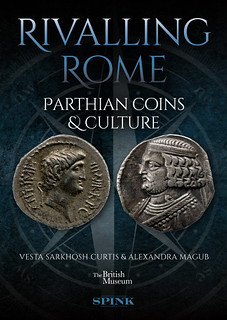 Rivalling Rome
Rivalling Rome
by Vesta Sarkhosh Curtis and Alexandra Magub
Product Code:5241
£20.00
In collaboration with the British Museum.
Paperback.
ISBN: 9781912667444
One hundred years after the conquest of the Persian Empire by Alexander of Macedon a new Iranian dynasty emerged that by 140 BC had extended its rule to Western Iran and Mesopotamia. The Arsacid Parthians, famous for their riding and archery skills, became Rome's most dangerous enemies east of the River Euphrates. Encounters between Rome and Parthia are vividly described in classical accounts, but these are biased in their nature and, unfortunately, no equivalent sources are available from the Parthian side. Here, the most important primary source is the coinage of the period c. 248 BC - AD 224.
These coins reveal important information about the development and expansion of the Parthian state, as well as the all-important role of the king, with the ancient Persian title King of Kings adopted under Mithradates II. Rome's involvement in the region began during this reign and culminated in the devastating defeat of the Roman army under the general Crassus at the Battle of Carrhae in 53 BC. Over the next 300 years these superpowers fought for territorial control in the region, particularly over Mesopotamia and Armenia.
For more information, or to order, see:
Rivalling Rome by Vesta Sarkhosh Curtis and Alexandra Magub
(http://www.spinkbooks.com/index.php?route=product/product&path=59/&product_id=736)
NEW BOOK: TRAGEDIES IN ROMAN EUROPE
David Sundman forwarded this new book offering from Siatras Books in Athens, Greece. Thanks. -Editor
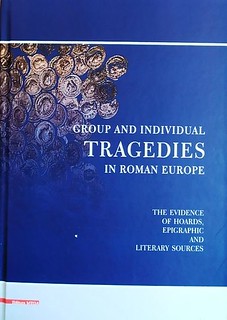 GROUP AND INDIVIDUAL TRAGEDIES IN ROMAN EUROPE: THE EVIDENCE OF HOARDS,
EPIGRAPHIC AND LITERARY SOURCES
GROUP AND INDIVIDUAL TRAGEDIES IN ROMAN EUROPE: THE EVIDENCE OF HOARDS,
EPIGRAPHIC AND LITERARY SOURCES
By Cristian Gazdac
Condition: Brand new
ISBN 10: 6060201318
ISBN 13: 9786060201311
Cluj-Napoca, 2020. In English. Papers on Roman hoards of coins found around Europe. Hard cover, 29 cm, 556 pp., ill.; shipping weight 3 kg. ISBN: 978-606-020-131-1.
Here's a sampling of the papers found within. See the complete list online. -Editor
Bitrak, Sanja / Pero Josifovski
HOARD OF ROMAN SILVER COINS FROM THE ROMAN FORUM IN STOBI
Bland, Roger
COIN HOARDS IN THE ROMAN EMPIRE: A LONG-RANGE PERSPECTIVE. SOME PRELIMINARY OBSERVATIONS
Cattaneo, Alessandro
RECOGNIZING HOARDS IN COLLECTIONS. A POSSIBLE III CENTURY HOARD FROM THE STROLIN COLLECTION IN CHIO (VI)
Van Heesch, Johan
COIN HOARDS AS EVIDENCE OF TRAGEDIES. SOME GENERAL REMARKS ON THE NORTH OF GAUL (3RD CENTURY AD)
Štajer, Leilani
HISTORICAL RESEARCH THROUGH COIN HOARDS
Stroobants, Fran
THE USE OF COINAGE FOR LARGE PAYMENTS AT ROMAN SAGALASSOS (SW ANATOLIA). COMBINING EVIDENCE FROM HISTORICAL SOURCES, COIN FINDS AND REGIONAL HOARDS
Talma?chi, Gabriel M.
ABOUT SOME MONETARY FINDS IN FUNERARY CONTEXT FROM MOESIA INFERIOR
For more information, or to order, see:
GROUP AND INDIVIDUAL TRAGEDIES IN ROMAN EUROPE: THE EVIDENCE OF HOARDS, EPIGRAPHIC AND LITERARY SOURCES By Cristian Gazdac
(https://www.biblio.com/book/group-individual-tragedies-roman-europe-cristian/d/1318144430)
NEW BOOK: LES ALEXANDRES APRÈS ALEXANDRE
Here's another new book offering from Siatras Books. -Editor
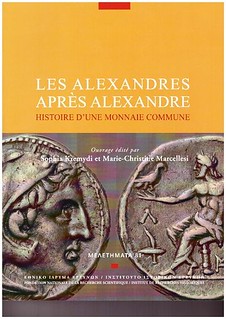 Les Alexandres Après Alexandre: Histoire D'une Monnaie Commune
Les Alexandres Après Alexandre: Histoire D'une Monnaie Commune
By Sophia Kremydi, Marie-Christine Marcellesi (Eds.)
Condition: Brand new
ISBN 10: 9609538967
ISBN 13: 9789609538961
Meletemata Series, No. 81. Festschrift. In honour and memory of Georges le Rider. Athens: National Hellenic Research Foundation, 2019 (released March 2020). Soft cover, 28 cm, 464 pp., ill.; net weight 1650 gr. Contains eight papers in English and six papers in French. ISBN: 978-960- 9538-96-1.
CONTENTS:
1. Introduction
2. Ch. GATZOLIS, Alexanders in the Balkans (except Thrace) until the Reign of Philip V
3. SOPHIA KREMYDI, Alexanders under the late Antigonids
4. ANDREW MEADOWS, The Development of the Civic Alexander Coinage in Western Asia Minor, c. 323 to 223 BC
5. FABRICE DELRIEUX, Les derniers monnayages aux types et au nom d'Alexandre le grand dans l'ouest de l'Asie Mineure (fin IIIe - debut IIe siecle)
6. OLIVER D. HOOVER, A Necessary Evil: Alexandrine Coinages and the Tension of Personal Kingship in the Seleucid Empire
7. FREDERIQUE DUYRAT, Phoenician Alexanders
8. EVANGELINE MARKOU, Between Alexander III and Ptolemy I: Production and Circulation of Posthumous Alexanders in Cyprus, Egypt and Cyrene
9. SELENE E. PSOMA, Alexandreiai drachmai, chrysoi alexandreioi and alexandreia tetradrachma in literary sources and inscriptions
10. FRANCOIS de CALLATAY, Apparition, utilisation et disparition de l'or monnaye au nom d'Alexandre le Grand: une monetisation massive sans croissance economique?
11. P. TSELEKAS, Silver Alexanders in the Balkans and the East. The Hoard Evidence for a Century Old International Coinage
12. V.E. STEFANAKI, La circulation des monnaies au nom et aux types d'Alexandre apres 230-225 av. J.-C. en Mediterranee orientale: le temoignage des tresors
13. CAROLINE CARRIER, L'heritage des alexandres en terre barbare: le cas des alexandres arabes (fin IIIe - debut IIe siecle avant J.-C.)
14. GARY REGER, Alexanders and the Hellenistic Economy
15. OLIVIER PICARD, Les alexandres apres Alexandre - Conclusions
Bibliographie
Liste des illustrations
Index des tresors
Concordance avec CH, IGCH et autres publications
Index general
The price includes the shipping cost.
For more information, or to order, see:
Les Alexandres Après Alexandre: Histoire D'une Monnaie Commune By Sophia Kremydi, Marie-Christine Marcellesi (Eds.)
(https://www.biblio.com/book/alexandres-apres-alexandre-sophia-kremydi-marie/d/1306829326)
BOOK REVIEW: PAST & NEARLY PERFECT
Henry Nienhuis edits The Canadian Numismatic Journal and submitted this review of Rob Turner's new book Past & Nearly Perfect, which was just published by the Royal Canadian Numismatic Association through a grant from the J Douglas Ferguson Historical Research Foundation. Thanks. -Editor
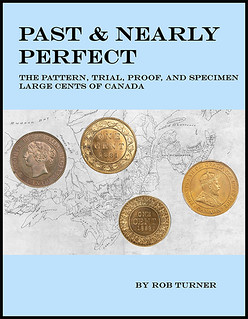 Rob Turner, Bowman Award winning author, has once again knocked it out of the ballpark with his new book, Past & Nearly Perfect. Turner's latest work focuses on the
extremely rare Patterns, Trial Pieces, as well as the Proof and Specimen coins which exist in the Canadian Large Cent series; from the early design of the first provincial cent to the last large cent issued by the Dominion in 1920. While it is
somewhat of a departure from his previous four books that deal with in-depth die studies of Canadian Victorian Large Cents, he continues to apply his exacting and in-depth research methodologies to this new subject matter. It is a worthy addition to
the most discerning numismatic libraries.
Rob Turner, Bowman Award winning author, has once again knocked it out of the ballpark with his new book, Past & Nearly Perfect. Turner's latest work focuses on the
extremely rare Patterns, Trial Pieces, as well as the Proof and Specimen coins which exist in the Canadian Large Cent series; from the early design of the first provincial cent to the last large cent issued by the Dominion in 1920. While it is
somewhat of a departure from his previous four books that deal with in-depth die studies of Canadian Victorian Large Cents, he continues to apply his exacting and in-depth research methodologies to this new subject matter. It is a worthy addition to
the most discerning numismatic libraries.
Written from the perspective of "who made them and why they were made", Turner includes a detailed history of the people and events associated with the production of these extremely rare numismatic treasures. Past & Nearly Perfect documents the role played by key people, such as Alexander Galt, Thomas Graham and Charles Fremantle, in the development of Canadian coinage, which resulted in production of these special strikes. This also includes many interactions between the Canadian Government and the Royal Mint in London. In Past & Nearly Perfect, Turner applies his extensive knowledge of die production and usage in the Canadian Large Cent series to the subject matter, as well as, his first-hand detailed research in the archives of the Royal Mint Museum in Llantrisant, Wales.
With a quick glance through Turner's new book I think you'll agree that it is obvious that the author has taken meticulous care assembling the many high resolution, full-colour images; many of which were taken during the course of the author's research and have never been seen before.
The book is divided into eight chapters with three appendices. The contents are:
Preface i
Chapter 1 Proofs, Specimens, And Other Confusing Things 1
Chapter 2 Designing a Provincial Cent 9
Chapter 3 Postdated Coins and Other Oddities of the 1870's 45
Chapter 4 The Change to Dominion Cents 61
Chapter 5 Heaton Specimen Cents 79
Chapter 6 Victorian Specimen Record Cents 91
Chapter 7 Later Royal Mint Specimen Cents 109
Chapter 8 Ottawa Specimen Cents 123
Appendix A Record Coins Sent to Other Museums 137
Appendix B Special-Strike Large Cents in the NCC 157
Appendix C Bibliography 159
The book was published by the Royal Canadian Numismatic Association, made possible by a grant from the J. Douglas Ferguson Historical Research Foundation.
Turner, Rob. Past & Nearly Perfect. Printed in Canada, 2020. 164 pp. Illustrated with colour photographs. ISBN 978-1-55383-526-4; 8.5" x 11", heavy glossy paper, hard bound, 49.95 CAD*
*The book is available from the RCNA website for CA$49.95 ($44.95 for members) plus shipping and handling.
For more information, or to order, see:
Past & Nearly Perfect (https://www.rcna.ca/book/index.php)

VIDEO: FINANCE MUSEUM OUT OF THE VAULT
Earlier this month the Museum of American Finance began a new series of videos highlighting key objects from their collection. -Editor
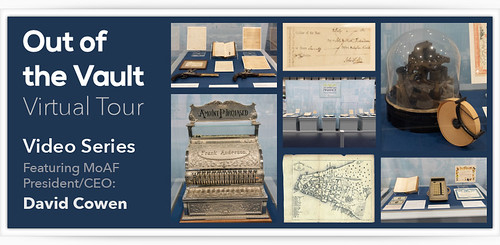
This is part one of the Museum of American Finance's new video series based on its "Out of the Vault" exhibit.
In November 2018, the Museum staged this exhibit at the Schwab IMPACT Conference in Washington, DC. "Out of the Vault" showcased some of the most unique, interesting and historical artifacts in the Museum's collection, many of which have never before been on public display.
Featured objects included some of the nation's founding financial documents, such as Alexander Hamilton's Report on the Public Credit—considered to be the economic equivalent of the US Constitution— as well as the 1792 George Washington bond, which was signed by President Washington and is believed to bear the first use of the dollar sign on a US federal document.
Many artifacts were signed by American political and business leaders from the 18th century through today, while others highlighted technological innovations that transformed the financial services industry. Together, these objects represented more than 225 years of American financial history and achievement.
David Cowen, the Museum's President/CEO, narrates this video series from his home during the COVID-19 lockdown.
About the Museum
Finance impacts everyone. As a socially relevant organization, the Museum of American Finance seeks to improve understanding of the influence of financial institutions and capital markets on the US and global economies, and on individuals' lives.
The nation's only independent museum dedicated to finance and financial history educates the public through exhibits, financial literacy programs and public events. The Museum, an affiliate of the Smithsonian Institution, seeks to empower
individuals of all backgrounds to strive toward financial independence, while encouraging curiosity and discovery.
To watch the video, see:
Out of the Vault – Part 1 (https://www.youtube.com/watch?v=mpRQGuydRDc)
For more information on the Museum of American Finance, see:
https://www.moaf.org/
NEWMAN PORTAL DIGITIZES NUMISMATIC NEWS
Great news: the latest acquisition for the Newman Numismatic Portal is Numismatic News! Project Coordinator Len Augsburger provided the following report. -Editor
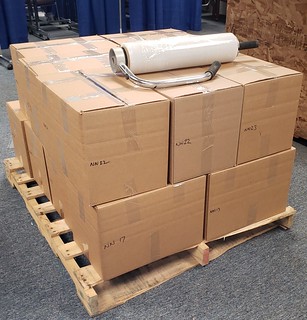 Illustrated here is one of two pallets holding the reference set of Numismatic News, about 2,000 issues, which is held by the Iola (WI)
Historical Society. This material, with the kind assistance of George Cuhaj and Cliff Mishler, was shipped to Washington University in St. Louis just prior to the CV-19 closures. We were able to scan about 70 issues prior to the shutdown and look
forward to resuming as the campus reopens in phases.
Illustrated here is one of two pallets holding the reference set of Numismatic News, about 2,000 issues, which is held by the Iola (WI)
Historical Society. This material, with the kind assistance of George Cuhaj and Cliff Mishler, was shipped to Washington University in St. Louis just prior to the CV-19 closures. We were able to scan about 70 issues prior to the shutdown and look
forward to resuming as the campus reopens in phases.
A big thanks to George Cuhaj for personally packing all of this material and handling shipping logistics with the Iola Historical Society. Numismatic News will be scanned at Washington University on a large-format Atiz scanner.
While this content remains in-copyright and will not be available for full-view on Newman Portal, brief snippets will appear in NNP search results and provide users sufficient context to determine if a specific issue is of interest. Similarly, Newman Portal previously digitized Coin World, with the assistance of Beth Deisher, Rick Amos, and the American Numismatic Society. Although presenting these publications with full-view would be optimal, we felt that digital preservation of this content was sufficiently compelling to proceed with the work. These two journals form an important record of numismatics for the period covered and contain numerous articles reported nowhere else.
What a marvelous acquisition! This will make decades worth of great numismatic research and writing easily discoverable by researchers. -Editor
NNP ADDS SCRIPOPHILY AUCTION SALE CATALOG
Another recent addition to the Newman Numismatic Portal is a guide to worldwide scripophily auction sales. Project Coordinator Len Augsburger provided the following report. -Editor
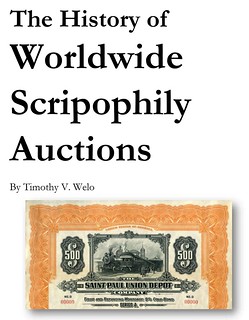 Newman Portal Adds Scripophily Auction Sale Catalog Guide
Newman Portal Adds Scripophily Auction Sale Catalog Guide
In the 1980s, Martin Gengerke's and John Adams' guides to numismatic auction sale catalogs created order from the chaos, providing easy to use references that finally revealed, in one place, what existed and what did not. The Gengerke guide covered a massive 18,000 catalogs, while Adams concentrated on the most significant firms through 1975, and further graded the content of each sale for 26 individual classifications. If someone wanted to enumerate, for example, the most significant sales of U.S. gold coins, a few minutes spent with the Adams references would produce such a list.
Tim Welo, under the sponsorship of the Eric P. Newman Numismatic Education Society (EPNNES), has now produced a similar guide for the field of scripophily – covering stock, bond, and other financial certificates. This study covers 54 auction sales and over 2,600 auction sale catalogs. The work is now freely available in both spreadsheet and compiled form.
Link to Tim Welo guides on Newman Portal:
https://nnp.wustl.edu/library/booksbyauthor/534990
VIDEO: INTERVIEW WITH ROBERT HENDERSHOTT
These are selections from the David Lisot Video Library that feature news and personalities from the world of coin collecting. David has been attending coin conventions since 1972 and began videotaping in 1985. The Newman Numismatic Portal now
lists all David's videos on their website at:
https://nnp.wustl.edu/library/multimediadetail/522852
Here's an interview with Bob Hendershott. -Editor
Living History: Robert Hendershott, February 1989
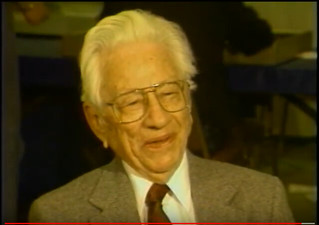 Robert "Bob" Hendershott started his coin collecting at the turn of the century. Hear this early interview done by David Lisot at the Long Beach Expo in 1989. Sponsored by Professional Numismatists
Guild.
Robert "Bob" Hendershott started his coin collecting at the turn of the century. Hear this early interview done by David Lisot at the Long Beach Expo in 1989. Sponsored by Professional Numismatists
Guild.
An excerpt of the video is available for viewing on the Coin Television YouTube Channel at:
https://youtu.be/l8rwc21vy5w
To read earlier E-Sylum articles, see:
ROBERT L. HENDERSHOTT, 1898-2005 (https://www.coinbooks.org/esylum_v08n13a02.html)
BOB HENDERSHOTT AND THE 1904 WORLD'S FAIR (https://www.coinbooks.org/esylum_v08n13a03.html)
A TRIBUTE TO BOB HENDERSHOTT (https://www.coinbooks.org/esylum_v08n14a19.html)
AUDIO: PIERRE FRICKE ON CONFEDERATE PAPER MONEY
The latest Coin World podcast includes an interview with Confederate paper money expert Pierre Fricke. -Editor
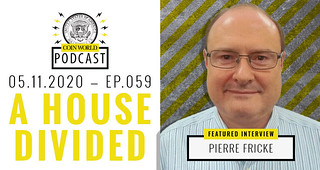 Jeff and Chris have a long conversation with Pierre Fricke, an expert in Confederate paper money. Numerous fascinating anecdotes ensue.
Jeff and Chris have a long conversation with Pierre Fricke, an expert in Confederate paper money. Numerous fascinating anecdotes ensue.
To read the complete article, see:
A House Divided — Talking Confederate Paper Money with Pierre Fricke (https://www.coinworld.com/news/us-coins/cwpod_ep059)
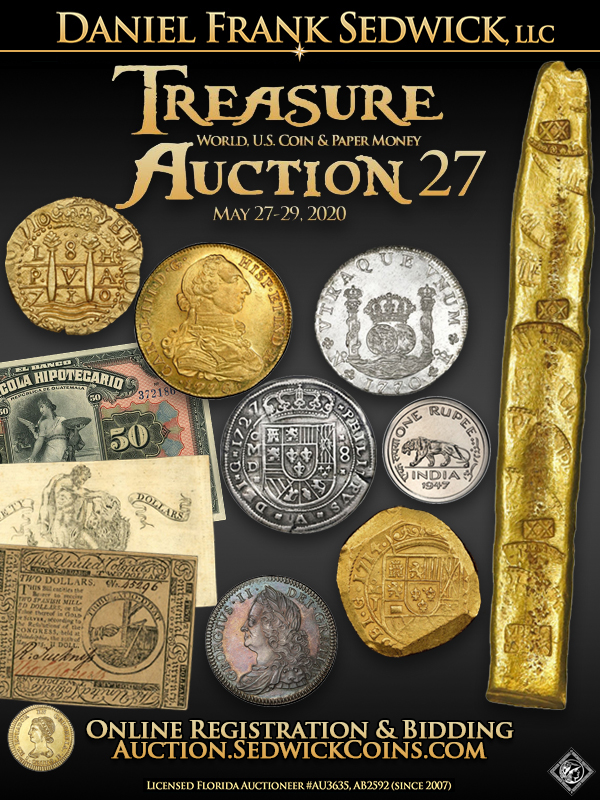
DRS. RUSH AND STEPHEN GIRARD VS. YELLOW FEVER
Numismatists know Dr. Benjamin Rush who served as treasurer of the United States Mint from 1797–1813. This book excerpt from the Delancey Place blog highlights the service of Rush and financier Stephen Girard during Philadelphia's Yellow Fever epidemic. -Editor
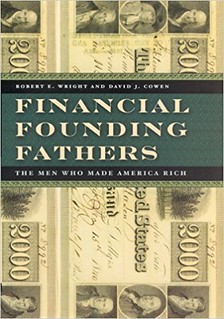 Today's encore selection -- from Financial Founding Fathers: The Men Who Made America Rich by Robert E. Wright and David J. Cowen.
Today's encore selection -- from Financial Founding Fathers: The Men Who Made America Rich by Robert E. Wright and David J. Cowen.
French-born Philadelphian Stephen Girard, an international merchant and trader, was perhaps the richest man in America in the late 1700s and early 1800s. With assets of $7 million at his death ($200 million in today's dollars), he was also one of America's greatest philanthropists. In 1793, a yellow fever epidemic forced George Washington, the U.S. government and almost every citizen of means in Philadelphia to leave. Girard, richest of them all, stayed behind saving lives:
"Unlike many philanthropists, Girard did not wait until he died to start helping others. His finest hour occurred during Philadelphia's great yellow fever epidemic in 1793. That episode, largely forgotten in American history, was one of the greatest disasters to befall any American city. The gravity of the epidemic increases when one realizes that Philadelphia was at the time the nation's temporary capital. Yellow fever, so named because the victim's skin turns a yellowish hue, is fatal to as many as half of those who contract it. If the afflicted does not successfully resist the disease, he dies a tortuous week-long death filled with bouts of high fever, chills, black vomit and diarrhea. Were this not awful enough, the alleged cure for the malady, the one pushed by Philadelphia's leading physician, the famed Dr. Benjamin Rush, involved bloodletting and mercury purges. Rush, like Girard, bravely stayed in town and tried his utmost to aid the sick. Unfortunately, Rush's harsh treatment plan caused untold deaths.
"In 1793, the population of Philadelphia and its suburbs was approximately 45,000 [the largest in America]. ... Before the epidemic ended with the November frosts, some four to five thousand Philadelphians, about 10 percent of the city's population, lay yellowed and dead in pools of vomit and excrement. In a typical day, just prior to the plague, an average of three Philadelphians died. On October 11, at the peak of the plague, 119 persons met their excruciatingly painful end. ...
"No one great or small was immune to this plague. None other than Alexander Hamilton caught the fever on September 5. Soon thereafter, his beloved wife Betsy also became ill. Dr. Edward Stevens saw to their recovery, which became instant front-page news. Stevens's treatment was much milder than the aggressive bloodletting and purging that Dr. Rush espoused. Soon, controversy over the proper course of treatment divided Philadelphia's doctors and leading citizens. ...
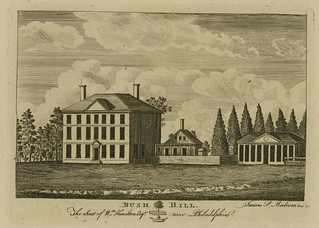 "Stephen Girard could have, indeed should have, simply left town. But instead, he chose to risk his life to save others. ... He rolled up his sleeves and plunged into the fight, the fight against the
disease itself, the fight against physicians with quack cures, the fight for the honor of the French refugees who many blamed for the scourge, and the fight for his business and reputation. Unlike some fifty merchants who ran away and reneged on
their financial obligations, Girard defended his credit, his honor, his people, his city. ... When the call went out for volunteers, only thirty-seven stepped forward. Clearly the hospital at [Philadelphia's] Bush Hill was no place for the faint
of heart; the stench of death, vomit and excrement filled the nostrils, overpowering even the strongest. After inspecting conditions at Bush Hill, Girard realized that such a small number of volunteers would prove insufficient unless they were
efficiently organized. Therefore, at the September 16 meeting of the emergency plague committee, Girard and fellow Philadelphian Peter Helm offered to supervise the volunteers. Girard's actions, which many viewed as a death sentence, took
observers aback.
"Stephen Girard could have, indeed should have, simply left town. But instead, he chose to risk his life to save others. ... He rolled up his sleeves and plunged into the fight, the fight against the
disease itself, the fight against physicians with quack cures, the fight for the honor of the French refugees who many blamed for the scourge, and the fight for his business and reputation. Unlike some fifty merchants who ran away and reneged on
their financial obligations, Girard defended his credit, his honor, his people, his city. ... When the call went out for volunteers, only thirty-seven stepped forward. Clearly the hospital at [Philadelphia's] Bush Hill was no place for the faint
of heart; the stench of death, vomit and excrement filled the nostrils, overpowering even the strongest. After inspecting conditions at Bush Hill, Girard realized that such a small number of volunteers would prove insufficient unless they were
efficiently organized. Therefore, at the September 16 meeting of the emergency plague committee, Girard and fellow Philadelphian Peter Helm offered to supervise the volunteers. Girard's actions, which many viewed as a death sentence, took
observers aback.
"But Girard was not suicidal. ... Like Hamilton, Girard, who was conversant with the principles of medicine due to his youthful experience as a sailor, shunned Dr. Rush's harsh treatments in favor of the milder approach of Dr. Stevens. Moreover, Girard did not believe that the disease was contagious, attributing the far-reaching nature of the epidemic instead to the widespread distribution of the city's filth. ...
"For sixty straight days Girard managed the makeshift hospital and cared for the ever-growing number of sick. ... A contemporary observer noted that Girard had to perform 'many disgusting offices of kindness for (the patients), which nothing could render tolerable, but the exalted motives that impelled him to this heroic conduct.'"
To read the complete article, see:
STEPHEN GIRARD AND THE YELLOW FEVER -- 5/14/20 (https://delanceyplace.com/view-archives.php?p=4108)
To read the earlier E-Sylum article, see:
BOOK EXCERPT: FINANCIAL FOUNDING FATHERS (https://www.coinbooks.org/v20/esylum_v20n13a08.html)
CORONAVIRUS UPDATES: MAY 17, 2020
Here's the latest compilation of coronavirus updates from readers, organizations and companies. -Editor
June Long Beach Expo Cancelled (May 14, 2020)
Bob Steinberg passed along word that the June 2020 Long Beach Expo has been cancelled. -Editor
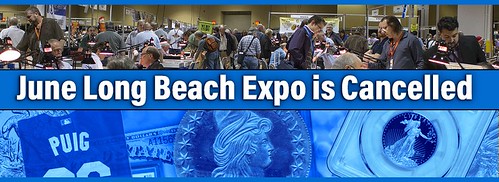
From the announcement:
"The Long Beach Expo, leading coin, currency, stamp and sports collectible show on the West Coast, today announced it has canceled its June 2020 expo due to the ongoing COVID-19 health pandemic and in compliance with Governor Gavin Newsom's March 12, 2020 Executive Order to cancel all large gatherings. The Long Beach Expo plans to return to the Long Beach Convention Center, September 17-19, 2020.
"The health and well being of our expo community is of the utmost importance to us," said Cassi East, President of the Long Beach Expo. "Due to the escalating concerns around the spread of COVID-19 at large community events, we have made the difficult decision to cancel the June show and plan to return to the Long Beach Convention Center this September. We appreciate the ongoing support and help of everyone involved as we work through this challenging and uncertain time together."
"If you are interested in participating in the June 4-7, 2020 Long Beach Expo U.S. Coins Signature Auction hosted by Heritage Auctions, Heritage Auctions will be accepting online and phone bidding only."
To read the complete article, see:
Long Beach Expo Cancels June 2020 Expo, Plans to Return in September (http://www.longbeachexpo.com/news/2020/161)
Smallpox Vaccine Developed (May 14, 1796)
From The Writer's Almanac for May 14, 2020:
"It was on this day in 1796 that the doctor Edward Jenner inoculated an eight-year-old boy with a vaccine for smallpox, the first safe vaccine ever developed.
"What made it so remarkable was that Jenner accomplished this before the causes of disease were even understood. It would be decades before anyone even knew about the existence of germs.
"Jenner submitted a paper about his new procedure to the prestigious Royal Society of London, but it was rejected. The president of the Society told Jenner that it was a mistake to risk his reputation by publishing something so controversial.
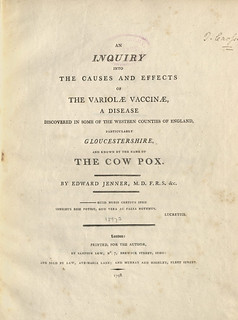 "So Jenner published his ideas at his own expense in a 75-page book, which came out in 1798. The book was a sensation. The novelist Jane Austen noted in one of her letters that she'd been at a
dinner party and everyone was talking about the "Jenner pamphlet." The procedure eventually caught on, and it was called a "vaccine" after the Latin word for cow. It wasn't perfect at first, because of poor sanitation and dirty needles, but it was
the first time anyone had successfully prevented the infection of any contagious disease."
"So Jenner published his ideas at his own expense in a 75-page book, which came out in 1798. The book was a sensation. The novelist Jane Austen noted in one of her letters that she'd been at a
dinner party and everyone was talking about the "Jenner pamphlet." The procedure eventually caught on, and it was called a "vaccine" after the Latin word for cow. It wasn't perfect at first, because of poor sanitation and dirty needles, but it was
the first time anyone had successfully prevented the infection of any contagious disease."
To read the complete article, see:
The Writer's Almanac for Thursday, May 14, 2020 (http://www.garrisonkeillor.com/radio/twa-the-writers-almanac-for-may-14-2020/)
To read more about Edward Jenner, see:
Edward Jenner and the Development of the Smallpox Vaccine
(https://nyamcenterforhistory.org/2016/05/13/edward-jenner-and-the-development-of-the-smallpox-vaccine/)
Feisel Token Auction Date Change (May 14, 2020)
Duane Feisel writes:
"Since the printed May issue of "Talkin' Tokens" with the auction listing has nor yet been delivered to NTCA members, I am forced to reschedule the closing to June 27/28. This is a major inconvenience, but it appears the USPO is having real problems!
An example - this morning I went to the Shingletown PO to mail a Registered Priority. Although there were two clerks present, neither of them knew how to handle a Registered mailing -- pretty incredible!
If you would like to receive a copy of the auction listing by email, please let me know.
Descriptions and images for many of the tokens being offered can be viewed at: https://tinyurl.com/vv5mzmt
Note that the image numbers for the lots pictured on this site are not the auction lot numbers. However, the image description does provide the lot number that must be used for bidding.
This is one of my most outstanding auctions since I began twice-a-year auctions 26 years ago!"
To read the earlier E-Sylum article, see:
DUANE FEISEL TOKEN SALE CLOSING NOVEMBER 30, 2019 (https://www.coinbooks.org/v23/esylum_v23n17a20.html)
Stack's Bowers and Ponterio Hong Kong Auction Date Change (May 15, 2020)
From the announcement:
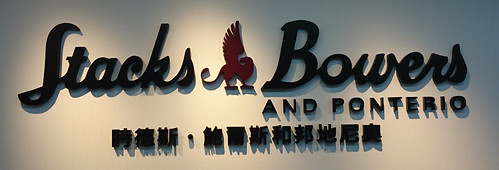 "Fresh off the success of their monumental 10th Anniversary Hong Kong auction earlier this month, Stack's Bowers and Ponterio has finalized new dates for their next sale focused on
Chinese and other regional rarities. Previously slated for August 17-20 in conjunction with the Hong Kong Coin Show (HKCS), this auction will now take place October 5-8, 2020 and be held at the Mira Hotel as have previous Stack's Bowers and Ponterio
Hong Kong sales. It will not be held alongside the HKCS, which plans to retain its original August dates.
"Fresh off the success of their monumental 10th Anniversary Hong Kong auction earlier this month, Stack's Bowers and Ponterio has finalized new dates for their next sale focused on
Chinese and other regional rarities. Previously slated for August 17-20 in conjunction with the Hong Kong Coin Show (HKCS), this auction will now take place October 5-8, 2020 and be held at the Mira Hotel as have previous Stack's Bowers and Ponterio
Hong Kong sales. It will not be held alongside the HKCS, which plans to retain its original August dates.
The shift in dates will allow the firm to space out the time between the two annual sales, the first of which had been postponed nearly two months due to the global pandemic caused by the COVID-19 coronavirus. Despite this postponement and the overall uncertainty that has gripped the globe, the firm was pleased to announce that their 10 th Anniversary sale brought incredible results, with total prices realized achieving $13.2 million—154% of the high estimate! This extra time between spring and fall sales will allow for additional consignments to be added, ensuring that the October auction will be as wildly anticipated as the recently-completed May event. The firm has set a new consignment deadline of July 17, replacing the previous date of May 29. To find out more about consigning, email Consign@StacksBowers.com or call 800-566-2580 to speak to a numismatic expert."
Shanna Schmidt (May 15, 2020)
In her Newsletter #153 Shanna Schmidt writes:
"Hello all my "social distancing" friends! As time moves forward, I learn more about our new existence and am trying to modify the way I do business. I'm no different than many people in our business. If I think too long about what is happening it frankly scares me a bit. That said, I believe that in our business/hobby we have the ability to work together with our partners in the U.S. and abroad and still accomplish our goals. I'm starting to embrace the virtual meetings. The "Long Table" series through the ANS has become my new Friday @ noon meeting! I just like to see my friends (and sometimes customers) and talk about coins for an hour. This is open for everyone. Just join the ANS which is well worth the money. I'm trying to push such initiatives at the ANA as well and curator Doug Mudd is already on top of it! We should expect to see podcasts soon from the ANA. Pandemic or not, we should be doing this kind of thing through our small network."
I've attended three of the American Numismatic Society's Zoom meetings in recent weeks and all have gone well. It's a great way to sit in on conferences and seminars. The audio and video quality has been acceptable and I do expect that not only will more clubs adopt the practice, that it will continue long after the pandemic has subsided. It's cheap and easy to do, and provides a great way to connect with members. -Editor
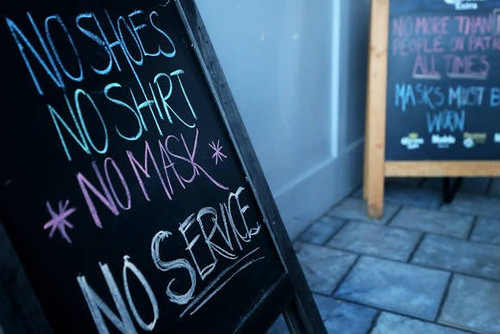
To read the earlier E-Sylum article, see:
CORONAVIRUS UPDATES: MAY 10, 2020 (https://www.coinbooks.org/v23/esylum_v23n19a15.html)
MORE ON STACK'S FIXED PRICED LISTS
Dan Hamelberg submitted this great report on Stack's fixed priced lists. Thanks! -Editor
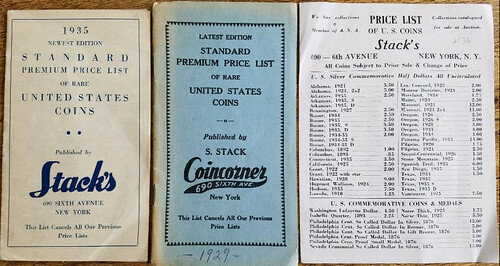
The post regarding the Stack's fixed priced lists gave me a reason to go thru my Stack's FPL's. I have a total of 62 lists from 1947 to 1994. I am missing 3 lists from the 40 or so now listed on NNP for the period 1947 - 1994. (Spring 1949 as #44a, Book List 1992 and 1994 Fixed Price List) I have some 22 lists that are not listed on the NNP.
Since I had all the Stack's FPL's now out and counting, I decided to go back to the early lists before 1947, and the FPL's in my collection after 1994. The earliest Stack's FPL I have is not dated but I believe is from 1929/1930 with an address of 690 6th Ave., New York. It is a small sized "pocket list" with the front cover title of "Coincorner." I have two other lists from the same address dated 1935 and 1936.
Some time in the late 30's, Stack's moved to 32 W. 46th St and I have a list dated 1939 at that address. I believe the 1939 list is the first of 76 lists that are numbered consecutively from 1939 to 1970. FPL #28 from January 1943 marks the first FPL from a new address at 12 W. 46th St.
Fixed Price List # 53 (1953) marks the move to 127 W. 57th St. The run of 76 lists includes two lists numbered 66; one list numbered 66a, one list numbered 44a and a list from 1969 titled "Treasure of 1715." That would suggest a total number of lists in the run as 80. Not all lists in this run are dated. Additionally, there were lists printed during the 39' to 70' period outside of the consecutive numbers.
I have 6 broadside lists along with other lists that are undated but most likely produced within the period run. I am missing numbers 39, 52, 55, and 59, but some of the undated lists I have might represent some of those numbers. Not sure. There were 4 other early FPL's contained in the Stack's auction catalogs of 4/18/36, 6/13/36, 10/30/36 and 3/19/37. These were 4 page lists at the end of the catalogs. My Stack's FPL run ends in 2006.
All total, I have 135 Stack's FPL's including the 4 contained in early catalogs. With the 3 lists missing from my collection along with a few more lists unknown to me at this time I would imagine the total number of Stack's FPL's produced from the start to 2006 will total over 135. How far over? Just another numismatic mystery.
Thanks, Dan. Great collection! -Editor
To read the earlier E-Sylum article, see:
STACK'S FIXED PRICE LISTS ON NEWMAN PORTAL (https://www.coinbooks.org/v23/esylum_v23n19a10.html)
MORE ON GLENN SMEDLEY
Tom DeLorey submitted these thoughts on Glenn Smedley. Thanks. -Editor
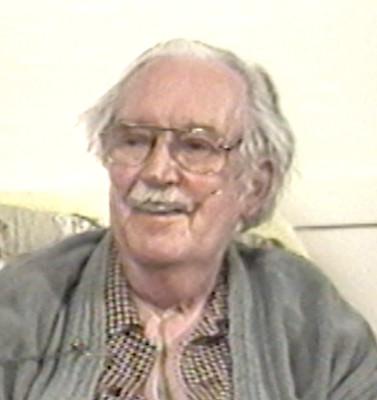 I
enjoyed the memories of Glenn Smedley. He came into ANA Headquarters every day as a retired volunteer while I was on staff at ANACS, and was always a pleasure to be around. He had a wealth of knowledge about what was then the old days at the ANA. I
fear that that knowledge of the past is now forgotten.
I
enjoyed the memories of Glenn Smedley. He came into ANA Headquarters every day as a retired volunteer while I was on staff at ANACS, and was always a pleasure to be around. He had a wealth of knowledge about what was then the old days at the ANA. I
fear that that knowledge of the past is now forgotten.
He did not drive, explaining to me that he had grown up in Chicago which had such a good public transportation system that he had never needed to. I believe that he worked for the Edison company in Chicago for most of his life. A few times when we were both going to an ANA Convention I would give him a ride to the airport. He had taken on the Editorship of the Numismatist as an Assistant to Elston Bradfield in Chicago, and moved to Colorado Springs to help transition the Editorship to the then new Headquarters building. This came at the cost of some personal sacrifice, as he had difficulty breathing at the altitude and wore a small portable oxygen tank with the breathing tubes you see in the video. When I would pick him up to go to the airport he would leave it behind, saying he did not need it at sea level. He never complained about needing it.
I happen to own a set of three mahogany bookcases he had custom built to hold his (then, as Editor) complete set of The Numismatist. He moved them to Colorado, sold them to me when he downsized his apartment, and I moved them back to Chicago in 1984 before returning to Colorado in 2013. Perhaps I will leave them in my will to the Editorial Department.
Dave Bowers passed along this still-useful list handed down through Glenn from the original "Mr. Redbook", Richard Yeo. Thanks! -Editor
Glenn B. Smedley, one of the most respected numismatists on the scene, in September 1959 contributed an article to The Numismatist, "Books to Buy or Borrow," which told of a list handed to him by Richard S. Yeoman, editor of A Guide Book of United States Coins, plus some additions, bringing the list up to include the following, which were considered to be the basic numismatic library:
- Early Coins of America (Sylvester S. Crosby 1875),
- The State Coinages of New England (Miller and Ryder 1920),
- The United States Half Cents (Ebenezer Gilbert 1916),
- Early American Cents, 1793-1814 (Dr. William H. Sheldon 1949),
- United States Copper Cents, 1814-1857 (Howard R. Newcomb 1944),
- United States Half Dimes (Dr. W. Valentine 1931),
- United States Dimes (Abe Kosoff 1945),
- Type Table of U.S. Dollars, Half Dollars and Quarter Dollars (John W. Haseltine 1881),
- Early Quarter Dollars (A.W. Browning 1925),
- A Register of Half Dollar Die Varieties (M.L. Beistle 1929),
- U.S. Pattern, Trial and Experimental Pieces (E.H. Adams and William Woodin 1913),
- Private Gold Coinage of California (Edgar H. Adams 1913),
- California Gold Quarters, Halves and Dollars (Ed. M. Lee 1932),
- Silver and Gold Coins of the World (J.W. Scott 1913),
- Copper and Nickel Coins of the World (J.W. Scott 1913),
- A Guide Book of United States Coins (R.S. Yeoman 1959),
- A Catalog of Modern World Coins (R.S. Yeoman 1957),
- Catalog of the Jenks Collection (Henry Chapman 1921),
- Historia Numorum (Barclay V. Head 1887),
- The Types of Greek Coins (Percy Gardner 1883),
- Roman Coins (Harold Mattingly 1928),
- A History of Banking in the United States (John Jay Knox 1900),
- History of American Coinage (David K. Watson 1899),
- History of Currency in the United States (A. Barton Hepburn 1915),
- Fractional Money (Neil Carothers 1930),
- U.S. Paper Money—Old Series (Dr. F.A. Limpert 1948),
- Paper Money of the United States (Robert Friedberg 1955),
- Dictionary of Numismatic Names (Albert R. Frey 1917), and
- Numismatic Bibliography (Phares O. Sigler 1951).
Some classic works, many well worth reading even when newer works on the topic are available. Fractional Money remains one of my all-time favorites. -Editor
To read the earlier E-Sylum article, see:
VIDEO: GLENN B. SMEDLEY INTERVIEW (https://www.coinbooks.org/v23/esylum_v23n19a11.html)
NOTES FROM E-SYLUM READERS: MAY 17, 2020
One of the Great Pleasures of Collecting
David Gladfelter offers this quotation from the late Colin Narbeth. Thank you. -Editor
"Writing up the collection is one of the great pleasures of collecting. The ability of a collector, his skill at selecting, and his general research can be judged by the finished product. Basically, the collector is setting out to tell a story, illustrated by the notes themselves."
-Colin Narbeth, Collecting Paper Money (London: B. A. Seaby Ltd., 1986), 29.
To read the earlier E-Sylum article, see:
COLIN NARBETH (1929-2020) (https://www.coinbooks.org/v23/esylum_v23n19a09.html)
Numismatic and Antiquarian Society of Philadelphia Building
John Byars writes:
"A quick look at the city directories shows a few different addresses for the Numismatic and Antiquarian Society of Philadelphia. The 1300 Locust building is still there and is a four story grand one. It housed numerous other Societies, Reading Rooms, etc.
"1867-70 / 524 Walnut
1875-85 / 1800 Chestnut
1893 / S.E. cor 21st & Pine
1898 / S. Broad & Pine
1904 / 708 S. Washington Sq
1905-06 / 312 Chestnut
1910-31 / 1300 Locust"
To read the earlier E-Sylum article, see:
NOTES FROM E-SYLUM READERS: MAY 10, 2020 : Dave Hirt on Riddell, Philadelphia Society (https://www.coinbooks.org/v23/esylum_v23n19a16.html)
More on Coronavirus Stimulus Checks
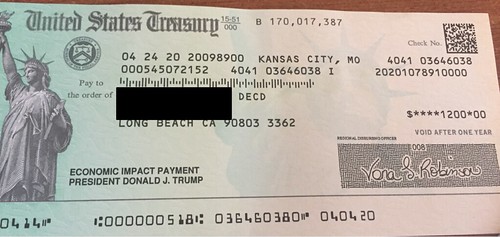
Kavan Ratnatunga passed along two articles on the topic of returning mistakenly-issued coronavirus stimulus checks to the U.S. government. Thanks. -Editor
The IRS said someone who died before receipt of the payment, a non-resident alien or someone who is incarcerated does not qualify for a check. These payments need to be returned if received, the IRS said.
To read the complete articles, see:
IRS stimulus checks labeled 'DECD' sent to deceased people anyway
(https://justthenews.com/government/federal-agencies/irs-stimulus-checks-labeled-decd-were-sent-deceased-people-anyway)
Stimulus check: Can you get one and how to find the IRS payment schedule
(https://www.cnet.com/personal-finance/stimulus-check-can-you-get-one-and-how-to-find-the-irs-payment-schedule/)
To read the earlier E-Sylum articles, see:
WILL CORONAVIRUS STIMULUS CHECKS BE COLLECTIBLE? (https://www.coinbooks.org/v23/esylum_v23n16a33.html)
NOTES FROM E-SYLUM READERS: MAY 3, 2020 : Coronavirus Stimulus Check Spotted (https://www.coinbooks.org/v23/esylum_v23n18a22.html)
Query: 1907 Philippine 1st legislative Session Medal
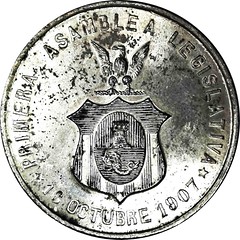
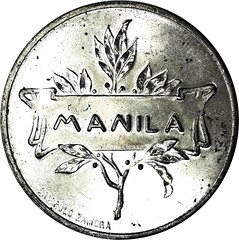
Aaron Dembinsky writes:
"I have been searching endlessly for information on a medal that I have. I have finally found some information that another collector I recently got in touch with kindly provided.
"The medal in question is the 1907 SILVERED BRONZE 1ST LEGISLATIVE SESSION HONEYCUTT-78a.
"I am attaching images the medal I have. I also had the Bronze version which I recently passed on to another collector - the same gentleman that provided me with the below link.
"I was hoping your readers can shed some light on the background of this silvered version of the medal and what its value may be. I see that one sold at auction in March 2019 but I can not find any records of the realized price.
"Any and all information will be really appreciated."
Interesting medal. Can anyone help? -Editor
To read the complete article, see:
JAA Philippine Medals & Tokens 1907 SILVERED BRONZE 1ST LEGISLATIVE SESSION HONEYCUTT-78a
(https://coins.www.collectors-society.com/wcm/CoinView.aspx?sc=632998)
Query: Connecticut State Library Pattern Coins
Saul Teichman writes:
"Has anyone imaged the pattern coins in the Connecticut State Library ? I am working on a photo library for many of the U.S. Pattern coins and could use color images of about 57 coins. Any help readers can provide would be greatly appreciated."
Query: Don Taxay
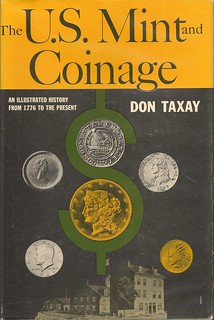 Dave Bowers is putting the finishing touches on a book describing American numismatics from 1932 to date for Whitman. He asks if anyone has further information on Don Taxay. The topic has come up before, but
the question of his disappearance and whereabouts have never been answered. -Editor
Dave Bowers is putting the finishing touches on a book describing American numismatics from 1932 to date for Whitman. He asks if anyone has further information on Don Taxay. The topic has come up before, but
the question of his disappearance and whereabouts have never been answered. -Editor
"A leading light in numismatic research in 1964 was Don Taxay, formerly with New Netherlands Coin Company, who was appointed curator of the Chase Manhattan Bank Money Museum. This museum was operated for a few years, after which the bank donated the coins to the American Numismatic Society. Taxay disappeared from view with some suggesting he went to India to engage in some type of meditation or spirituality."
Query: Privately Printed Numismatic Publications
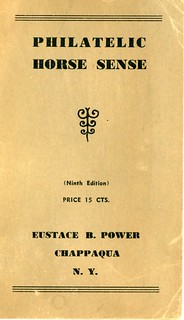
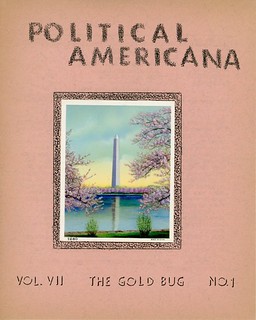
Robert W. Rightmire writes:
"I'm looking for names of individuals who privately printed a numismatic publication that appeared regularly for at least five years.
"Examples from other collecting fields:
- Political items: C.W. Fishbaugh
- Sport and non sports cards: Jefferson Burdick
- War Covers (philatelic): Delf Norona
- Philately in general: Eustace Power"
Interesting question. I'm sure there are some, but the timeframes can be difficult to determine sometimes. -Editor

PETE SMITH'S ART GALLERY
Pete Smith submitted this article on his oil paintings related to the First United States Mint. -Editor
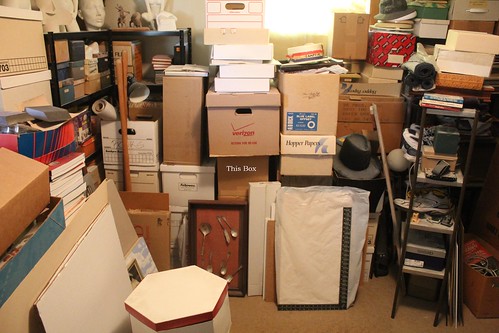
The Summer issue of The Asylum was posted on-line on Friday, May 15, 2020. This includes "Evolution of a Numismatic Library Part I."
One of the contributors is the ruggedly handsome Dr. Joel J. Orosz. He includes photos of cherished artwork on his walls including a 1947 oil painting by Frank Joseph Reilly titled "A Specimen of the Work of America's First Mint Examined by it Director in 1792." He also proudly shows Carlton Eddy's 2017 oil painting showing Thomas Jefferson recording in his Memorandum Book on July 13, 1792. Orosz clearly prefers this artwork to that which was unfortunately chosen as the cover illustration for a soon forgotten book.
This prompted me to grab a camera and record items displayed in my art gallery. The photo shows a box marked, "This Box" in white. This label was added to the photo and does not appear on the actual box.
The box includes nine original oil paintings related to the First United States Mint. Two appeared in The Secret History of the First United States Mint and four appear in 1792: Birth of a Nation's Coinage. The remaining three are rejected early versions of the published paintings.
Great art hangs on the walls of museums and private collections. Then there is the other stuff that gets packed away in boxes never to appear again in public.
Here's one of the paintings illustrated in the Summer 2020 issue of The Asylum. -Editor
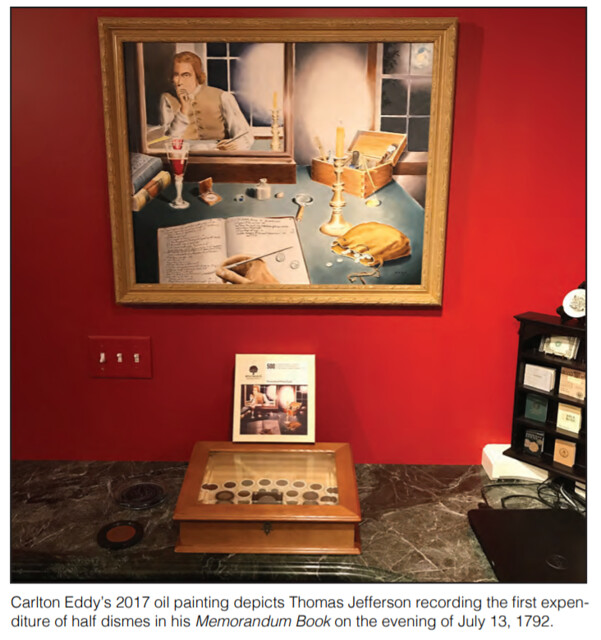
APPROVED GRADERS ON EBAY
David Barrette of Douggin World Coins writes:
"In the Loose Change section of the last E-Sylum there was a piece entitled "Selling Coins on eBay." I have been a dealer selling coins on eBay since 2004. Item #9 in the story says if the item isn't one of the authorized third party graders recognized by eBay, you can still show the photo of the slab with the numerical grade. This is not true as I found out recently. The photo may not show the slab nor the grade assigned by the third party grading company. Please see a copy of my e-mail below. I hope this will help others before they have problems trying to put photos of slabs from unauthorized third party graders."
Thanks - here's the relevant section of the email from eBay Customer Service. -Editor
Listings for graded currency must have been graded by one of our approved companies. The eBay-approved grading companies are:
- American Numismatic Association Certification Service (ANACS)
- Independent Coin Graders (ICG)
- Numismatic Guaranty Corporation (NGC)
- Professional Coin Grading Service (PCGS)
- Paper Money Guaranty (PMG)
As for listings for ungraded coins and currency or raw currency: These must not include a non-approved grading company, numeric grade or estimated value anywhere in the listing and can't show an image of the item in a graded holder if the image shows a grade.
I would take that last instruction to mean that showing an image of a holder is OK but only if the grade and grading company name are cropped from or blotted out on the image.
But what about fourth-party grader Certified Acceptance Corp.? They're not on the approved list, so wouldn't CAC have to be excised from the listing and image as well? As a market leader that doesn't make sense. I see plenty of CAC stickers on eBay slab images. Is there a separate policy on stickers, or was CAC just left off this list somehow? -Editor
Mark Ferguson writes:
"My guess is that CAC is not on the list because there's a primary grading service – PCGS or NGC – that has graded the coin before CAC stickering. There could be other stickers on slabs as well, such as: PQ, Eagle Eye Photo Seal, etc."
To read the earlier E-Sylum article, see:
LOOSE CHANGE: MAY 10, 2020 : Selling Coins on eBay (https://www.coinbooks.org/v23/esylum_v23n19a41.html)
SURVEY: COLLECTING PREFERENCES
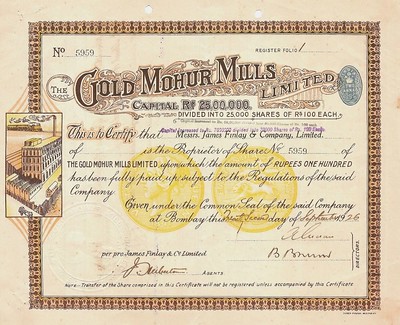
Scripophily is about collecting and researching antique securities, such as share certificates and government bonds. This is a 1926 share certificate in The Gold Mohur Mills Limited from Mumbai. Note the obverse and reverse of a Gold Mohur coin in the underprint.
Franky Leeuwerck, a member of the International Bond and Share Society, has a survey running on his blog relating to collector preferences. His survey questions are relevant to all numismatic collections. Beauty, scarcity, historical
significance, a good bargain and collection completeness, are incentives for collectors worldwide. You can participate anonymously. Access the survey here:
http://leeuwerck.blogspot.com/p/blog-page.html
I took the survey myself, and it's quick and fun. -Editor
VOCABULARY TERM: MARRIAGE MEDAL
Dick Johnson submitted this entry from his Encyclopedia of Coin and Medal Terminology. Thanks.
I've been unable to locate images of either of the two U.S. Mint marriage medals mentioned - can anyone help?
1821: Robert and Louisa Gilmore
1856: Samuel and Mary Bell -Editor
Marriage Medal. A medallic item issued on the occasion of a marriage or on the anniversary of a marriage. The most obvious design, of course, is portraits of the wedded couple. In addition to medals issued at the time of a wedding ceremony, anniversary medals have been issued on significant anniversaries. Most medallic companies offered stock medals for engagement, marriage and wedding anniversary themes. These dies could, of course, be engraved, or struck pieces inscribed to customize for any couple or occasion.
Royal families have issued marriage medals for centuries. The custom continues to he present, as exemplified by marriage medals issued for royal families in England, Bulgaria, Denmark, Sweden and The Netherlands.
Wedding anniversary medals are issued for the more important anniversaries, particularly 25th, 50th, 60th, and infrequently for the 40th or 75th. These are often instigated and sponsored by the children more so than anyone else. A wide range of marriage and wedding anniversary medals exist, from elaborately executed to stock designs. Royalty, wealthy and famous families have issued these medals, but so also have common folk. Generally only a sufficient quantity of marriage medals are struck to dispense to the relatives and friends who attend the wedding or anniversary celebration.
The United States Mint struck two marriage medals. One in 1821 for Robert and Louisa Gilmore (50th anniversary, Julian PE-13) and one in 1856 for Samuel and Mary Bell (25th anniversary, PE-5). Julian reports Mint Director James Ross Snowden traded restrikes of the Gilmore medal for coins he wanted in the mint collection. Otherwise marriage medals are seldom reissued or restruck.
In Germany oval wedding anniversary medals with loop for suspension, heavily enameled and jewel encrusted were called gnadenmadillen. These were popular among princes in the Holy Roman Empire.
References:
O37 {1977} Julian.
NE40 {1984} Junge p 118.
Looking for the meaning of a numismatic word, or the description of a term? Try the Newman Numismatic Portal's Numismatic Dictionary at: https://nnp.wustl.edu/library/dictionary
Or if you would like a printed copy of the complete Encyclopedia, it is available. There are 1,854 terms, on 678 pages, in The Encyclopedia of Coin and Medal Technology. Even running two a week would require more than 19 years to publish them all. If you would like an advance draft of this vital reference work it may be obtained from the author for your check of $50 sent postpaid. Dick Johnson, 139 Thompson Drive, Torrington, CT 06790.
ROBERT SAVAGE (1868-1943)
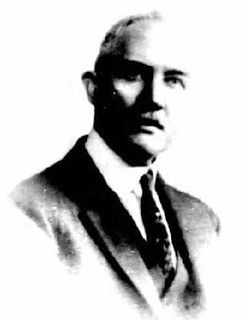 Robert Savage is one of the most distinguished American engravers of all time. He engraved postage stamps for several countries, bank notes and paper money for more than 31 countries, and corporate bonds,
and stock certificate vignettes during his tenure as an engraver - becoming Chief Engraver of the Picture Engraving Department of the American Bank Note Company (ABNC).
Robert Savage is one of the most distinguished American engravers of all time. He engraved postage stamps for several countries, bank notes and paper money for more than 31 countries, and corporate bonds,
and stock certificate vignettes during his tenure as an engraver - becoming Chief Engraver of the Picture Engraving Department of the American Bank Note Company (ABNC).
Robert Savage (1868-1943), was born on October 10, 1868 at Belfast, Ireland, son of Robert Savage Sr., (1830-1911). His family immigrated to America in 1872 settling in New York City.
In 1885, Savage became an engraver in the firm of Baldwin & Gleason, New York City. Thomas Gleason (1850-) was a former employee of the ABNC.
On March 19, 1887, he became a naturalized citizen of the United States of America.
On February 10, 1891, he joined the American Bank Note Company, Hunt's Point, Bronx, New York.
He married Mary Elizabeth, a native New Yorker, on July 25, 1896.
In 1907, Savage became Chief Engraver, Superintendent of the Picture Engraving Department of the American Bank Note Company, Hunt's Point, Bronx, New York
In September 1925, Savage retired from the ABNC.
In 1943, the ABNC asked Savage to help create the portrait of Chang-kai-shek. Leaving it unfinished he fell ill and died. The work was completed by engraver William Ford.
Savage died in Orlando, Orange County, Florida on July 23, 1943. He is buried at Woodlawn Memorial Park, Gotha, Orange County, Florida.
To read the complete article, see:
SAVAGE, ROBERT (http://www.numismaticmall.com/numismaticmall-com/savage-robert)
ROBERT WALLACE MCLACHLAN (1845-1926)
Darryl Atchison submitted this biography of Canadian numismatic pioneer Robert McLachlan. Thank you! -Editor
McLachlan, Robert Wallace (1845 - 1926)
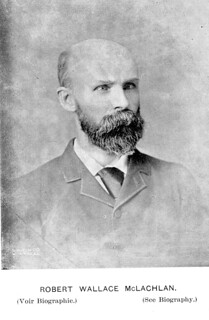 Robert Wallace McLachlan was born in Montreal on March 9th, 1845. He was educated at Huntingdon Academy, McGill Model School and McGill University. For over twenty years, he was an official in the archives department of
the Court House in Montreal from which position he retired in 1924. He was also a notary public for many years.
Robert Wallace McLachlan was born in Montreal on March 9th, 1845. He was educated at Huntingdon Academy, McGill Model School and McGill University. For over twenty years, he was an official in the archives department of
the Court House in Montreal from which position he retired in 1924. He was also a notary public for many years.
He began collecting coins when twelve years of age while a pupil at McGill Model School. The headmaster had persuaded all of his pupils to start coin collections. The copper circulating medium of Canada at that time was a heterogeneous collection of tokens, slugs and the coins of many countries. In fact, anything approximating the size and shape of a halfpenny was accepted as change. This proved to be a never failing mine from which a diligent collector could dig up rare and attractive specimens. The other pupils in the school soon lost interest in coin collecting but young McLachlan kept his collection intact and became more and more fascinated by the hobby as the years passed.
About the year 1862 he was permitted to see, what was to him, the wonderful collection of J.L. Brondson who proceeded to instruct his young friend in the best principles of coin collecting. He pointed out the importance of studying each coin, the procuring of a cabinet in which they could be carefully arranged and classified, the rejection of all poor and defaced specimens and the taking up of the Canadian series as a specialty. Acting on and profiting by these suggestions formed a new era for young McLachlan's collecting experience. From that time on he made classification of his coins one of the chief features of his collecting. While still very interested in ancient coins and adding to them when opportunity arose, he started energetically and perseveringly to form as complete a collection of Canadian coins, tokens and medals as possible.
In 1864 he was elected a member of the Numismatic Society of Montreal and over the years served as an officer in every grade save that of President. In 1868 he was elected a member of the Royal Numismatic Society and in 1926 received the award medal from that Society, the only Canadian to receive this award. He was a charter member of the British Numismatic Society and in 1884 he joined the American Numismatic Society. He joined the A.N.A. in 1899 but let his membership lapse and then rejoined in 1908 and in due time filled the offices of 2nd and 1st Vice-President. He twice ran for the office of President of the A.N.A. in both 1915 and 1916 - both times with H.O. Granberg as his rival candidate. He was soundly defeated in the 1916 election after have lost the previous year's ballot by a tiny margin of only 21 votes. He was a member of the Royal Society of Canada and acted as its President in 1915. He was a foreign associate member of La Societe de Numismatique de Belgique which he joined in 1887. He was also a member of La Societe Suisse de Numismatique.
He was a prolific writer on the coins and medals of Canada, his writings appearing in many numismatic periodicals as well as a number published under separate cover. His first published article appeared in the July 1872 edition of the Canadian Antiquarian and he continued to write for the next fifty years. He was without doubt the foremost authority on Canadian numismatics and received many honours as a result of his numismatic research and studies. When the golden era (1860- 1900) of Canadian numismatics was over, McLachlan virtually single-handedly kept the science of numismatics alive in Canada until the next wave of standard bearers took over in the 1920s and 1930s.
In 1922 he sold his entire collection (of about 20,000 pieces) as well as his numismatic library to the Antiquarian and Numismatic Society of Montreal. His collection was an integral part of the Society's holdings and was housed and displayed in the Chateau de Ramezay in Montreal until the collection was sold to the Bank of Canada in 1974. Regrettably, the Bank of Canada did not purchase the museum's library at the same time although it had been offered to them. The library was sold separately to a private collector in 1984 and the material was later sold by U.S. numismatic literature dealer, George Kolbe in the mid 1990s. Thus, Canada's earliest numismatic library (including rare books and original holographic manuscripts) left Canada forever. In fact, some of the museum's publications were later disbound so that pieces which had been bound together could be sold off separately. The library included McLachlan's set of William Elliott Woodward's auction catalogues (the finest set ever assembled - including 108 separate sales).
McLachlan died at his home on Westmount Avenue in Montreal on May 10th, 1926. He was inducted into the A.N.A. Hall of Fame in 1982.
(The information above is primarily from Collectors of Canadian Coins of the Past (1972) by Fred Bowman)
Biography : Numismatist : Vol. 27, no. 6 (June 1914) - p. 304 - 306 and Numismatist : Vol. 104, no. 1 (Jan. 1991) - p. 29
Obituary : Numismatist : Vol. 39, no. 6 (June 1926). - p. 290 - 293 and Spink's Numismatic Circular : Vol. 34 (1926) – p. 444

ROBB REPORT INTERVIEWS DWIGHT MANLEY
The Robb Report recently interviewed Dwight Manley, a lifelong numismatist known for marketing the S.S. Central America coins, his support of the American Numismatic Association's Dwight N. Manley Numismatic Library, and acquiring much of the Baker collection of Washington medals. Here's an excerpt - be sure to read the complete article online. -Editor
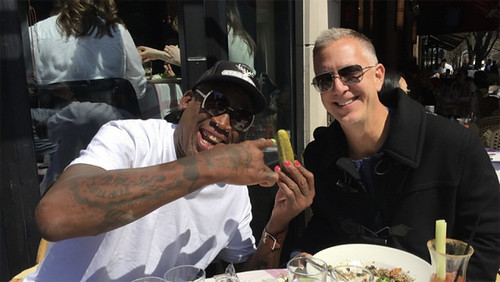
Dennis Rodman with former agent Dwight Manley
When the Chicago Bulls were atop the sporting world in the 1990s, winning six NBA titles in eight years, Michael Jordan was represented by David Falk, the sports-agent equivalent of His Airness. Falk represented as many as 40 players at the time. Meanwhile, Jordan's iconoclastic teammate Dennis Rodman, a pillar for the team's second three-peat, made a different choice. He hired a world-renowned coin collector from Orange County, Calif., named Dwight Manley to represent him.
Rodman may have been the NBA's most mercurial figure, but there was a good reason why he chose to work with Manley. The noted numismatist (the term for the coin and medal enthusiasts) may not have represented any other big-name athletes, but he had earned Rodman's friendship and trust in the years since they had first crossed paths in Las Vegas in the early '90s. Plus, as Manley put it, "It just seemed like whenever I was around him—whenever he was staying at the house—I found things that made him money off the court."
Rodman's incredibly successful three-year run in Chicago, in which the Bulls won three titles and the power forward led the league in rebounds each season, is once again in the spotlight due to ESPN's 10-part documentary The Last Dance. And the 54-year-old Manley, who was right there with his friend rubbing shoulders with Bulls superfans like Eddie Vedder and Billy Corgan, hopes the docuseries will remind everyone just how big of a deal those Bull teams were. The coin collector and agent recently spoke to Robb Report about his life's passion, his new prized coin collection and what it was like to represent Dennis Rodman during the Bull's dominance.
What were some of the items you were eyeing going into the sale?
I really liked the two-pattern half-dollars. So, the US Mint was founded in 1792 and issued the coinage officially in 1793. The two 1792-pattern half-dollars that had Washington on them—they're technically coins, pattern coins versus being [medals]. As a coin collector, I really liked those, and there's only a few known of each. The slave token, the emancipation for Henry Clarck, things like that. That's obviously unique to that person. That in itself is a collectible thing.
What about the emancipation medal sticks out to you?
That transcends coin collecting . . . That's a patriotic thing, something about good winning out over bad. That was literally someone's freedom in your hand. That's more than just buying something. That's your life. They didn't have driver's licenses, but that was somebody's life. I think that's pretty important.
You intend to make the collection accessible to the public, right?
Yes, I contacted the American Numismatic Association, and they're going to do an exhibition in 2021, which I am going to help underwrite for them. And ultimately it either tours from there or has a permanent home somewhere in a museum. I don't ever see myself selling it and having it be a for-profit event. It would be just as wrong for me to break it up or sell it, as I think it was for the museum to do that.
So, how did you go from being a coin collector to being Dennis Rodman's agent?
I think there's a similarity to buying and selling rare coins. Identifying something as a hidden gem and figuring out who needs it or wants it for the most money. With an athlete I see a lot of similarities in that. And I see Dennis, when I met him originally, when he had black hair and was a Piston, was like that. He was obviously scouted and on a team and playing on the highest level. But he still had so much more. The first thing I did for him was get him that book deal, and that became huge. As a platform, I think the published written word is still the most powerful thing to go in any direction you want.
We met in '93. [In] July 10, 1995, he was supposed to come for a few days to Orange County to stay at my house and then he never left.
How did you guys meet in the first place?
I was having dinner at the Mirage, and the host said do you want to meet Dennis Rodman . . . And then, after dinner, I said hello [and] played craps with him. After half an hour, I said nice to meet you and left. I went back [to Vegas] a week later for a bachelor party, and I walk right into him again. And I'm like, what are you doing here. And he says, oh, I didn't leave. That's weird, but I said, I'm going to George Carlin tonight, you want to go? Yes. So he comes with me. Next day, you want to come to the pool? Yeah. Next day going to Laughlin for this bachelor party, you wanna go? Yeah. And so we became friends, exchanged phone numbers. Then he got traded to San Antonio. He would come stay at the house in Orange County.
Final question: Do you have any advice for young collectors beginning to explore the world of coins?
I would give the same advice I was given: "Buy the book before the coin." There is nothing better than knowledge about that which one is interested in, whether to collect, or as a career, and learning about it is what makes the adventure all the more enjoyable.
To read the complete article, see:
Meet the World-Renowned Coin Collector Who Happened to Be Dennis Rodman's Agent in the '90s
(https://robbreport.com/shelter/art-collectibles/dwight-manley-coin-collector-dennis-rodman-agent-2917861/)
To read the earlier E-Sylum article, see:
DWIGHT MANLEY ACQUIRES BULK OF BAKER COLLECTION (https://www.coinbooks.org/v23/esylum_v23n09a28.html)
DONNA FRATER EXPANDS ANA ROLE
The ANA published this press release last week about a recent personnel change. -Editor
Donna Frater Named New ANA Director of Development & Membership
The American Numismatic Association (ANA) announced this week that Donna Frater has been named the new director of development and membership. Frater most recently served as the Association's manager of development.
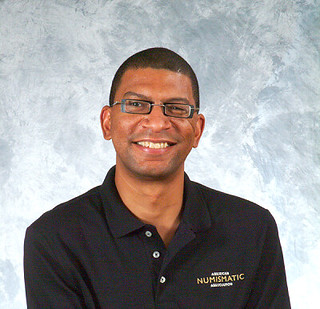 Frater is taking the reins from departing Membership Director Cary Hardy. A 22-year employee of the ANA, Hardy accepted a position with another nonprofit organization.
Frater is taking the reins from departing Membership Director Cary Hardy. A 22-year employee of the ANA, Hardy accepted a position with another nonprofit organization.
"Cary began his ANA tenure in our online merchandising store and moved through various positions to become membership director," says ANA Executive Director Kim Kiick. "He was responsible for a number of programs besides membership, including acting as the IT liaison for the Association and managing our relationships with affinity partners. He will be missed."
In her new expanded role, Frater will oversee ANA fund development, membership and the club/district representative program (assisted by Logan Curtis).
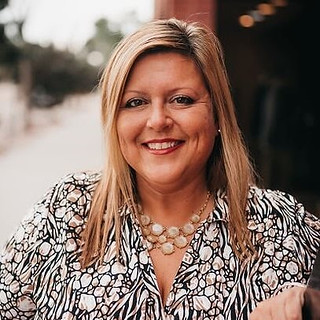 Frater has made a career of nonprofit service. Before joining the ANA in 2017, she served as the director of individual giving at Care & Share Food Bank for five years. Previous to that, she was the donor relations officer
at Pikes Peak United Way and also was employed at the Center for Nonprofit Excellence as the assistant director. A graduate of Truman State University with a BFA in Visual Communications, Frater is excited about her new role. "I'm running toward the
challenge," she says.
Frater has made a career of nonprofit service. Before joining the ANA in 2017, she served as the director of individual giving at Care & Share Food Bank for five years. Previous to that, she was the donor relations officer
at Pikes Peak United Way and also was employed at the Center for Nonprofit Excellence as the assistant director. A graduate of Truman State University with a BFA in Visual Communications, Frater is excited about her new role. "I'm running toward the
challenge," she says.
"Donna has a passion for customer service and I know our members will love working with her," says Kiick. "She is an idea person and I look forward to the contributions she will make in these vital ANA programs."
The American Numismatic Association is a congressionally chartered, nonprofit educational organization dedicated to encouraging the study and collection of coins and related items. The ANA helps its 25,000 members and the public discover and explore the world of money through its vast array of instructional and outreach programs, as well as its museum, library, publications and conventions. For more information, call 719-632-2646 or visit money.org.
Cary will be missed. I could always count on him being one of the first ANA staffers I see at a convention, manning the reservation desk. He was the go-to guy for member assistance, and I know he helped a number of ANA members with their subscription for the E-Sylum ANA Edition. Let's wish him luck in his new position, and welcome Donna in her expanded role. -Editor
ANA RACHEL CARSON 129TH CONVENTION MEDAL
The ANA has created a beautiful medal for its upcoming planned World's Fair of Money show in Pittsburgh. The Pennsylvania Association of Numismatists (PAN) published this press release. -Editor
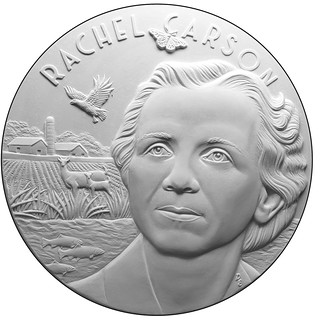
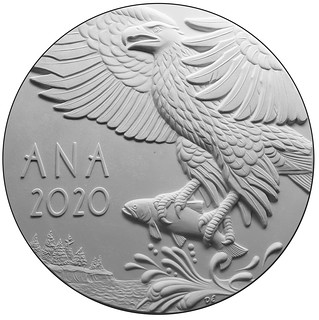
Plaster sculpts by Don Everhart
American Numismatic Association World's Fair of Money 129th Convention Medal created by Don Everhart
Retired United States Mint designer, sculptor, engraver Don Everhart has finished his plaster sculpts of the American Numismatic Association World's Fair of Money 129th Convention Medal. The medal depicts the bust of Pittsburgh area born environmentalist and biologist Rachel Carson.
The August 4th – 8th ANA Convention is in a state of uncertainty in light of the restrictions related to the Covid-19 pandemic. The ANA and the Pennsylvania Association of Numismatists are moving forward with the convention medal regardless of the annual numismatic gathering's fate. The medal will be produced in the sizes and metal compositions of previous ANA convention medals; 1.5" bronze, 2.75" bronze, and a two medal set of 1.5" bronze and silver. Pricing will be announced at a later date.
The medal design came as a result of a December 2019 PAN board meeting when board chairman Donald Carlucci queried those in attendance with medal topic preferences. Previous ANA / Pittsburgh medals have depicted John Mercanti's 1989 design of young Major George Washington overlooking the French advancement to the fork of the Ohio prior to the French and Indian War, Jamie Franki's 2011 ANA-National Money Show medal of Andrew Carnegie and Andrew Mellon obverse with a ladle pouring molten steel reverse. After some ideas and discussion Carlucci presented a very compelling presentation as to why a Rachel Carson medal would be appropriate today.
Rachel Carson was born in 1907 and was raised by her parents in a four-room house on sixty-five acres in Springdale, Pennsylvania along the Allegheny River. Her lifelong passion for the state of our natural world brought to the forefront man's unintentional damage to the environment. One of her books, Silent Spring, published in 1962 created quite the awareness controversy. On June 4th 1963 testifying before the United States Congress, Rachel Carson began: "Mr. Chairman, I appreciate the opportunity to discuss with you this morning the problems of environmental hazards and the control of pesticides. The contamination of the environment with harmful substances is one of the major problems of modern life. The world of air and water and soil supports not only the hundreds of thousands of species of animals and plants, it supports man himself." Ms. Carson's voice took on the powerful chemical industry. These unsafe compounds proved to be a major cause of the rapid decline of the American bald eagle population because of their feeding habits within the rivers and streams. The chemicals also affected the viability of our national bird's nest eggs that resulted in shell weakness that caused the eggs to crack and resulted in the continuing decline of the bald eagle population.
Mr. Carlucci's convincing discourse about the extraordinary life of Rachel Carson had the PAN board members sold on the idea. The next step was to contact ANA Membership Director Cary Hardy to acquire ANA approval. Initially when speaking of a medal subject, many questioned, who is Rachel Carson and why with so many Pittsburgh historical titans of industry would she be selected? A George Westinghouse medal certainly could be a more popular choice. A few things come into play to understand why. Her tireless work had a profound effect in preserving our national symbol that graces much of our coinage. The year 2020 marks the 100th anniversary of the passage of the 19th Amendment, guaranteeing and protecting women's constitutional right to vote. Women are more involved in numismatics today than at anytime in history including our ANA executive director and board members, owners and managing partners of large numismatic companies, coin show coordinators nation wide, the creation of the Women in Numismatics (WIN) organization, to the increasing number of young girls participating in young numismatist programs nationwide. The recognition and increasing awareness of global climate change is something that Rachel Carson would have had a profound interest in today if she were still alive. The ANA readily approved the creation of a Rachel Carson convention medal and the next step was to find an artist.
PAN has had a very good relationship with Don Everhart. His skill at design and portraiture sculpting is uncanny with his ability to capture the essence, passion and personality of the subjects. We witnessed this first hand when Don created the Pope Francis visit to Washington D.C. medal for PAN. The end result was perfect. PAN President Thomas Uram called Don and asked if he would be interested in designing and sculpting the Rachel Carson medal for the August ANA World's Fair of Money. He readily agreed to the project and went to work.
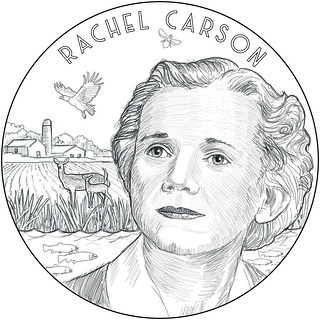
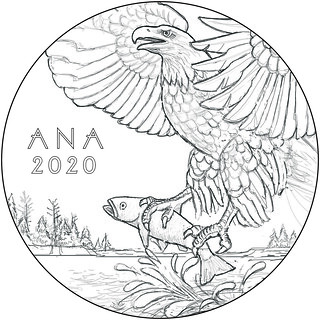
Design sketches by Don Everhart
Don Everhart's enthusiasm grew as the project progressed to these beautiful finished plaster sculpts. He describes the obverse and reverse as such:
"When designing the medal, I first re-read her book, "Silent Spring". I had read it when I was in elementary school and definitely needed a refresher. As stated before, the pesticides negative effect on the air, land, and water was particularly devastating. My obverse design attempts to illustrate all three elements of the natural world most affected by the use of chemicals to eradicate pests. An eagle flies in the sky, a deer and fawn browse on vegetation on a farmer's field while fish swim in a fast moving river. Her favorite butterfly, the Monarch is perched on her name. A solemn but hopeful look is present on the portrait of Carson. I am sure she would still be unsatisfied and still be battling for our environment had she lived today.
"For the reverse, I have depicted a Bald Eagle as it swoops down onto the water to snag a trout to bring back to the nest to feed her hatchlings. The American Bald Eagle has been a success story thanks to Carson's unwavering efforts to make our natural world more safe and livable. In fact, I have witnessed many eagles on my bike while riding in Pennsylvania and beyond. It is always a thrill to witness this majestic bird in flight. They are unmistakable with their size and white head and tail feathers as they glide through the air. They are usually found near a water source, where its main diet consists of fish.
"The American Bald Eagle deserves its place as our national symbol. To see one in flight is to witness one of the most majestic creatures to inhabit this precious earth that we all inhabit."
We are looking forward to the sale of the finished product and believe that the interest in this incredible lady will make this one of the most popular ANA Convention Medals to ever be offered.
ON USING NON-NUMISMATIC RESOURCES
David Powell submitted this article on using non-numismatic resources to solve numismatic puzzles. Thanks. -Editor
Following your article last week on useful numismatic resources, may I mention that non-numismatic articles in resources like the various online Newspaper Archives can also be very helpful for resolving numismatic problems, particularly in the area of exonumia/paranumismatics. With tokens, you often have some unknown which does not appear on the piece, or you wish to establish more accurately the period of issue. A couple of British examples to encourage readers to venture in this direction:
Example 1: Advertising piece. H.Pickles, Top of Green Market This is listed in Paul & Bente Withers' "Token Book 2".
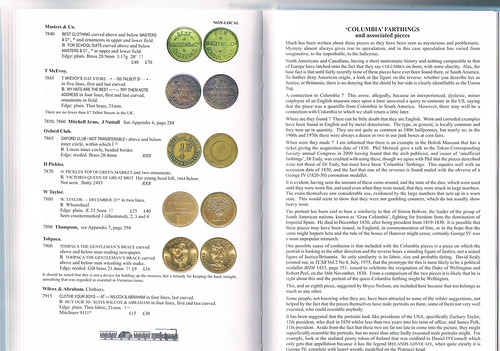

We need to know what town it comes from, and who is H.Pickles. Anything which links him to Top of Green Market will do; all Mr.Pickles has to do is commit some act which will get him and his address in the press together. It may be a business advertisement, or a birth/marriage/death announcement; but equally he may have got involved in a fist fight, fiddled his weights and measures, stolen or been stolen from, or witnessed someone else's criminal incident. The precise details of why he was there do not matter; anything which makes that link will do the job. Like this report in the Bradford Observer of 13 September 1849 regarding the awards given by the Bradford Floral and Horticultural Society at its annual show.
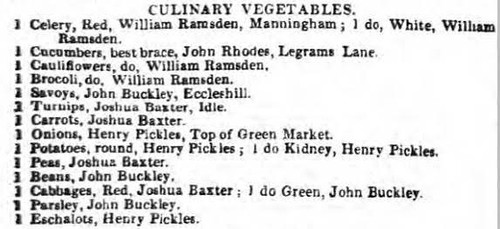
In all, Henry features four times, in 1849/52/55/57; all just about the time when the usage of these tokens was at its most popular. Glad you were a keen gardener, Henry, because otherwise we might never have known where your token came from.
Example 2: Uncertain piece, but almost certainly a sack deposit token. Alonzo Mills, East Ham
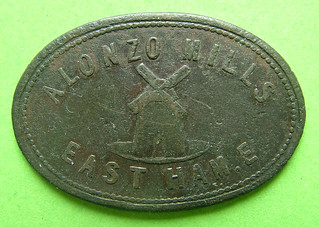 The token depicts a picture of a mill, with the words "ALONZO MILLS" above and "EAST HAM E" below. The area is a few miles to the east side of the City of London, in what was them still partly rural but has now long been
heavily built up. The reverse contains a value and nothing else.
The token depicts a picture of a mill, with the words "ALONZO MILLS" above and "EAST HAM E" below. The area is a few miles to the east side of the City of London, in what was them still partly rural but has now long been
heavily built up. The reverse contains a value and nothing else.
The question is, is Alonzo Mills a person or an industrial premises? From local newspapers in 1887 and 1892.
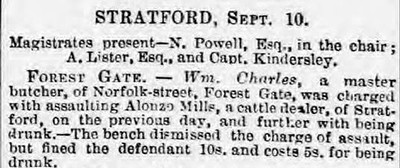
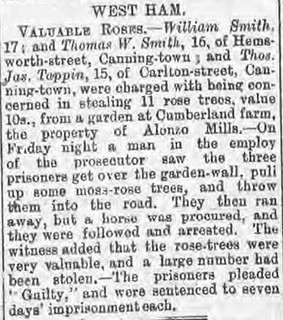
Problem sorted!
To read the earlier E-Sylum article, see:
USEFUL NUMISMATIC RESOURCES (https://www.coinbooks.org/v23/esylum_v23n19a25.html)
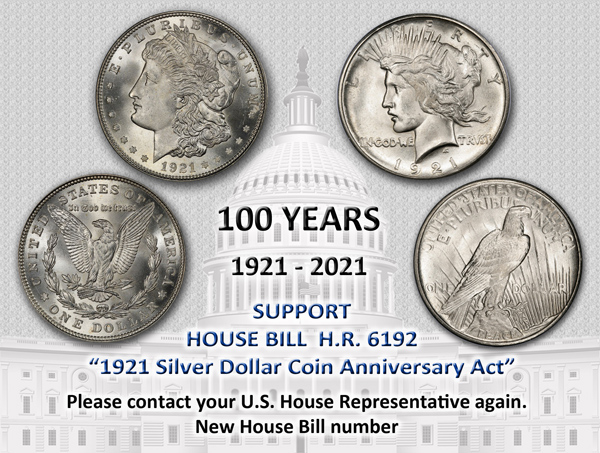
DANIEL FRANK SEDWICK AUCTION 27
Here's the press release for the Daniel Frank Sedwick Auction 27. Some great coins here. -Editor
Spanish colonial, Colombian coins star in Sedwick's May 27-29 Treasure Auction
A wealth of shipwreck gold and silver treasure plus a selection of Colombian numismatic rarities will star on May 27-29 in Daniel Frank Sedwick, LLC's online Treasure, World, U.S. Coin & Paper Money Auction 27.
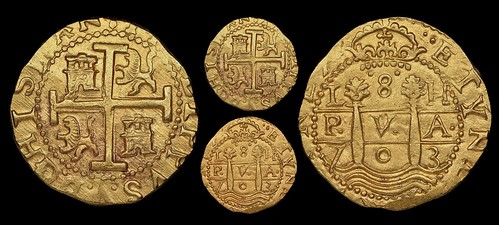
Lot 10: Lima, Peru, gold cob 8 escudos
As usual for this top auctioneer of Spanish colonial material, Sedwick's sale features many coins from famous shipwrecks, like the Spanish Plate Fleet of 1715, eleven ships that went down on July 31, 1715 off the east coast of Florida carrying gold and silver coins bound for Spain. Featured from the 1715 Fleet this time is a Lima, Peru, gold cob 8 escudos dated 1703 (lot 10), graded NGC MS 62 and estimated at $20,000 and up. It previously sold as ungraded in the 2003 Tampa sale of seized shipwreck treasure. This coin is so rare that even the State of Florida's own collection of 1715 Fleet coins is lacking an example.
Attracting further interest is a pair of Seville, Spain, gold cob 2 escudos, one each from the famous wrecks of the Atocha and Santa Margarita, sunk during the same storm in 1622 (lots 45 and 46). The Atocha 2 escudos is dated 1615 with a clear assayer's initial D and is graded PCGS AU50 while also accompanied by its original Mel Fisher certificate. Its estimate is $10,000 and up. The Santa Margarita 2 escudos is undated but also has the same assayer D and is graded PCGS MS61 with its Mel Fisher's Treasures, LLC certificate included. Its estimate is $6,000 to $9,000.
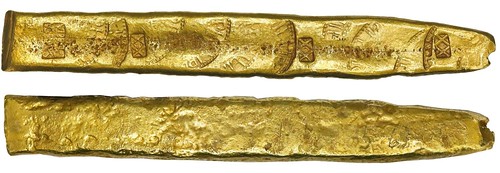
Lot 56: Colombian gold "finger" bar ex-Atocha (1622)
Although not a coin, a Colombian gold "finger" bar salvaged from the Atocha is a highlight, too. In a way, it acted as a form of money in its time by allowing a large sum of value to be transported from New World gold mines to the Spanish treasury. The long bar in this auction weighs 669 grams and has a marked fineness of 20.75 karats along with ten partial tax stamps of King Philip III. The bar was previously sold as lot 95 during the Christie's Atocha and Santa Margarita sale of June 1988. Its estimate in the Sedwick auction is $35,000 and up.
One of the finest Colombian coin collections assembled, the Nueva Granada Collection, representing Colombian rarities from the Spanish colonial era through the Republic period will appear in the sale's World Coins section. A key rarity is the Bogotá, Colombia, pillar 8 reales dated 1770VJ graded PCGS MS65. This coin is the single finest graded in the PCGS census and is finer than any others graded by NGC. Its estimate is $35,000 and up.
Colombian collectors will also want to watch for the auction's selection of Colombian bank notes. Most notably, the 1883-issued 10 pesos from the Estado Soberano de Bolívar bank in Cartagena will appear as lot 1341. The note is graded PMG XF 40 and is one of just two examples known today. The estimate is $7,000 and up.
Other highlights in the auction include:
• Lot 1291, a Mexico gold Cross of Tepeaca – Second Class military decoration from 1821, pedigreed to the J. Coolidge Hills collection and the American Numismatic Society archives. Estimate: $25,000 to $37,500.
• Lot 60, a large silver ingot from Oruro, Bolivia, 8 pounds 9.92 ounces troy, Class Factor 0.8, from the Atocha (1622) and pedigreed to the Caesar's Palace Auction of 1987. Estimate: $20,000 to $30,000.
• Lot 4, a Mexico City, Mexico, gold cob 8 escudos, 1714J, NGC MS 64, from the 1715 Fleet, finest known in the NGC census. Estimate: $15,000 and up.
• Lot 23, a Lima, Peru, gold cob 8 escudos, 1697/6H, NGC MS 64, from the 1715 Fleet. Estimate: $15,000 and up.
• Lot 478, a Mexico City, Mexico, silver cob 8 reales Royal, 1727D, NGC VF details / plugged. Estimate: $15,000 and up.
• Lot 854, a Medellín, Colombia, half peso, 1868, PCGS MS62, finest known in the PCGS census (and unlisted in the NGC census), pedigreed to the Nueva Granada collection and plated in Jorge Emilio Restrepo's Coins of Colombia (2012). Estimate: $15,000 and up.
• Lot 790, a Popayán, Colombia, gold bust 8 escudos, Charles III (bust of Ferdinand VI), 1761/0J, NGC MS 62, finest and only example in the NGC census. Estimate: $10,000 and up.
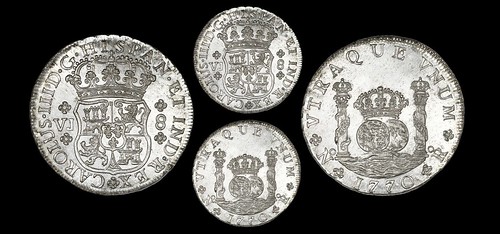
Lot 821: Bogota, Colombia, pillar 8 reales, Charles III, 1770VJ
• Lot 963, a Quito, Ecuador, gold 4 escudos, 1836FP, NGC MS 61. Estimate: $7,000 to $10,000.
• Lot 1232, a Seville, Spain, gold double excelente, Ferdinand-Isabel, NGC MS 64. Estimate: $7,000 to $10,000.
• Lot 1154, a Lahore, British India, nickel original proof rupee, George VI, 1947, PCGS PR63, finest and only example in the PCGS census. Estimate: $3,500 and up.
• Lot 1048, a Great Britain proof halfcrown, 1746, George II, VICESIMO on edge, PCGS PR63. Estimate: $4,000 to $6,000.
• Lot 439, a Mexico City, Mexico, silver cob 3 reales, Charles-Joanna, "Early Series," assayer gothic R, NGC VF details / saltwater damage, from the 1554 Fleet, pedigreed to the Potomac collection. Estimate: $3,500 to $5,000.
• Lot 793, a Bogota, Colombia, gold bust 8 escudos, Charles III, 1776JJ, PCGS MS64, finest known in both the PCGS and NGC censuses. Estimate: $3,500 to $5,000.
• Lot 1311, a Continental Currency $2, May 10, 1775, PMG Choice AU 58 EPQ Star, finest known in the PMG census. Estimate: $800 to $1,200.
• Lot 1355, a Guatemala, Banco Colombiano, 20 pesos, 1901, PMG Fine 12, finest and only example in the PMG census. Estimate: $2,500 to $3,750.
The four sessions will be held May 27-28 live online at auction.sedwickcoins.com. A fifth express session will follow on May 29. Bidders are encouraged to register in advance at auction.sedwickcoins.com.
STEPHEN ALBUM RARE COINS AUCTION 37
Here's the press release for Stephen Album Rare Coins Auction 37. Great material - love the medal! Don't forget to check out the literature lots - see the May 3, 2020 article on the Howard Bowker Numismatic Library (linked below). -Editor
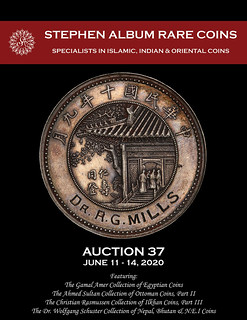 Stephen Album Rare Coins will hold its Auction 37 on June 11-14, 2020 at its offices in Santa Rosa, California. The auction is made up of 3,750 lots of Ancient, Islamic, Chinese, General World, and Indian
Coins, and includes 231 lots of Numismatic Literature, including selections from the H. F. Bowker Numismatic Library. Featured collections in this sale include the Gamal Amer Collection of Egyptian Coins, the Ahmed Sultan Collection of Ottoman Coins
(Part II), the Christian Rasmussen Collection of Ilkhan Coins (Part III), and the Dr. Wolfgang Schuster Collection of Nepal, Bhutan, and Netherlands East Indies Coins. The final two days will be comprised of 2 Internet-Only Sessions of lesser-priced
material. Some highlights from the sale follow:
Stephen Album Rare Coins will hold its Auction 37 on June 11-14, 2020 at its offices in Santa Rosa, California. The auction is made up of 3,750 lots of Ancient, Islamic, Chinese, General World, and Indian
Coins, and includes 231 lots of Numismatic Literature, including selections from the H. F. Bowker Numismatic Library. Featured collections in this sale include the Gamal Amer Collection of Egyptian Coins, the Ahmed Sultan Collection of Ottoman Coins
(Part II), the Christian Rasmussen Collection of Ilkhan Coins (Part III), and the Dr. Wolfgang Schuster Collection of Nepal, Bhutan, and Netherlands East Indies Coins. The final two days will be comprised of 2 Internet-Only Sessions of lesser-priced
material. Some highlights from the sale follow:
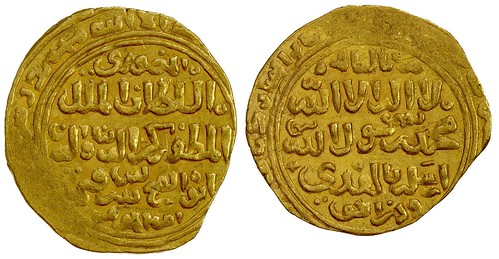
LOT 456. BAHRI MAMLUK: Baybars II, 1309-1310, gold dinar (4.61g), al-Qahira, DM, A-V916, with his slightly longer titulature al-sultan al-malik al-muzaffar rukn al-dunya wa'l-din abu'l-fath baybars qasim amir al-mu'minin al-mansuri filling the obverse field; this piece and the following lot are the only known gold coins of Baybars II of the al-Qahira mint (a third example was later discovered, but of the Dimashq mint, which appeared in St. James Auction 39, Lot 1113), EF, RRRR ex Gamal Amer Collection, ex Morton & Eden Auction, 23 April 2015, Lot 136. Estimated at $8,000 - 10,000.
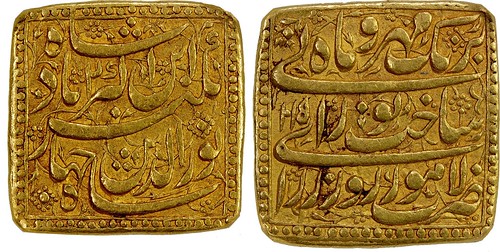
LOT 1066. MUGHAL: Jahangir, 1605-1628, gold square heavy mohur, Lahore, AH1015 year 2, KM-184.1, BMC-293 (1015 year 1) & 294 (1016 year 3), special presentation type from the early part of Jahangir's reign, obverse legend his full name & patronymic shah nur al-din jahangir ebn akbar padshah, and the regnal year "2"; reverse legend ruy-e zar-ra sakht nurani be-rang-e mehr o mah, "he made the face of money to shine with hues of the sun and moon", and the mint formula zarb Lahore, NGC graded AU55. Estimated at $14,000 - 16,000.
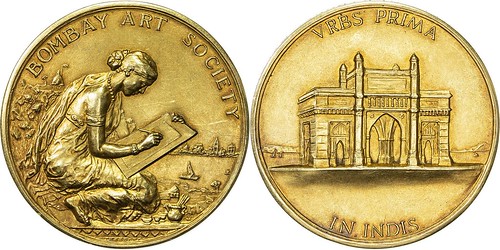
LOT 1333. BRITISH INDIA: gold medal (62.01g), 1928, Pud-948.7.1, 51mm gold medal, woman seated in sari, sketching, looking over Bombay harbor scene, BOMBAY ART SOCIETY above, geometrical patterns in exergue // Gateway of India at center with VRBS PRIMA / IN INDIS (First City in India) around, on edge, ETHEL GERTRUDE MACMILLAN / AWARDED 1928, and 18CT stamp with hallmark, struck at the Bombay Mint, EF, RRR. Estimated at $7,000 - 9,000.
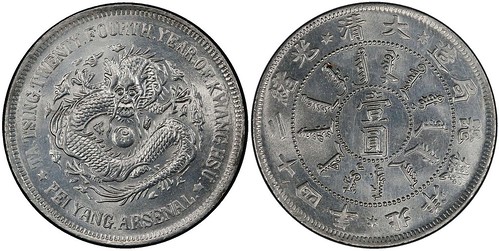
LOT 1462. CHIHLI: Kuang Hsu, 1875-1908, silver dollar, Peiyang Arsenal mint, Tientsin, year 24 (1898), Y-65.2, L&M-449, dragon eyes in relief, a superb quality example with bright white original mint luster, a superb example! PCGS graded MS63. Estimated at $15,000 - 20,000.
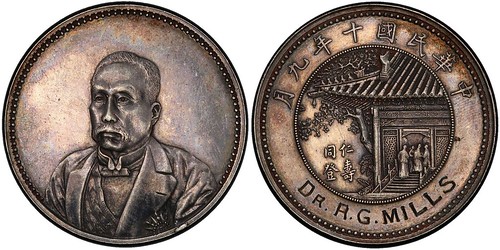
LOT 1448. CHINA: Republic, silver dollar, year 10 (1921), Kann-676a, L&M-957, Hsu Shih-chang "Pavilion" type, plain edge without bottom legend variety, hand engraved DR. R. G. MILLS on reverse, PCGS graded AU details, RR. This type was issued to commemorate the succession of Hsu Shih-chang to the office of President in 1918, and in celebration of his 67th birthday. Estimated at $7,000 - 9,000.
Dr. Ralph Garfield Mills (1881-1944) of Lincoln, Illinois, was Professor of Pathology and Director of Research at Severance Medical College (now Severance Hospital of the Yonsei University Health System), from 1911 until 1918 in Seoul, Korea. According to the Johns Hopkins University circular "Annual Report of the Johns Hopkins University 1913-14" published in Baltimore, Maryland in 1915, Dr. R. G. Mills, "an instructor in Pathology and Surgery resigned to become Professor of Pathology and Surgery in the new Peking Union Medical College in Peking", China in 1918. He was also listed as the Vice-President of the Korea Branch of the Royal Asiatic Society in Seoul in 1916.
In 1923 Dr. R. G. Mills, was again head of the department of pathology of the Peking Union Medical College and he wrote about the previous year in which "two of the contending war lords whose forces were clashing near Peking retired from the sanguinary scene of their conflict leaving several hundred wounded soldiers in an old temple. The Peking Union Medical College authorities commandeered all the suitable vehicles that could be found and brought the wounded men into the great city hospital." Dr. Ralph G. Mills and his wife, Ethel, served as missionaries in Korea and China.
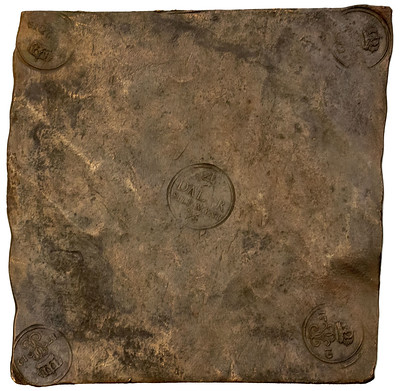
LOT 1872. SWEDEN: Ulrika Eleonora, 1718-1720, AE 4 daler, Avesta, 1719, KM-PM62, type II "plate money", corner stamps: crowned Queen's monogram dividing date, and center stamp: 4 DALER SILF: MYNT above pair of crossed arrows, some minor weakness of strike, but otherwise a superb example of this rare large type! EF, RR. Estimated at $4,000 - 6,000.
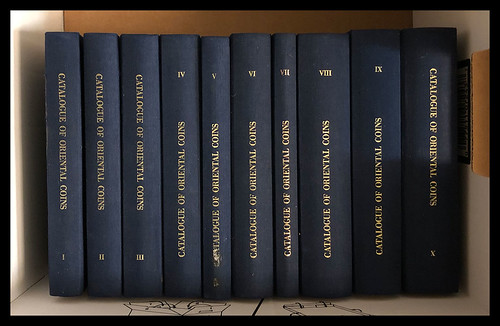
LOT 3607. LITERATURE: Lane-Poole, Stanley, Catalog of Oriental Coins in the British Museum: Ten Volume Set, Originally published by the British Museum, London, 1875-1890, reprinted by Forni Editore, Bologna, 1967, all hardcover. Each volume includes historical and numismatic overviews. The corpus itself includes complete Arabic legends written out. Each volume has numerous indexes to legends, mints, rulers, etc. (See online description for highly detailed information about each volume). Complete set of 10 volumes, ex. Jim Farr Numismatic Library. Estimated at $500 – 700.
The firm is now accepting consignments for its Auction 38, which will be held September 10-12, 2020. More information can be found on their website at www.stevealbum.com
To read the earlier E-Sylum article, see:
H. F. BOWKER NUMISMATIC LIBRARY SALE (https://www.coinbooks.org/v23/esylum_v23n18a02.html)
WAYNE'S NUMISMATIC DIARY MAY 17, 2020
Without coin shows or club meetings to go to, my Numismatic Diary has been set aside for a while. One highlight is always the meeting of my northern Virginia numismatic social group, Nummis Nova. The dinners are always great fun and feature the sharing of interesting numismatic items from our members' collections. My diaries of the meetings include a number of images of the exhibited material.
This week I reached out to our members and they've shared some of their recent acquisitions and other great items virtually.
Early Odd Denomination Notes
Dave Schenkman acquired these two great scrip notes in a recent Heritage sale.
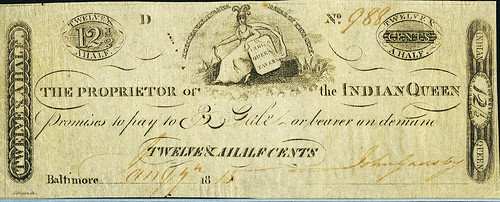
1815 Indian Queen 12 1/2 Cent Scrip Note, Baltimore, MD
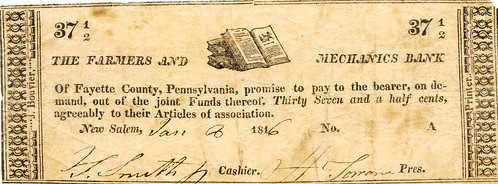
1816 Farmers and Mechanic Bank note, Fayette County, PA
Dave writes:
"The 1815 12 1/2 cent note from the Indian Queen Tavern in Baltimore is signed by the owner, John Gadsby, who also owned Gadsby's Tavern in Alexandria."
Gadsby's Tavern hosted events for George Washington and the building still stands. Nummis Nova has held a few of our dinner meetings there. Great numismatic connection. -Editor
Rare Mining Notes
Dave shared these two rare mining notes as well, also from the recent Heritage sale. The Cherokee Iron Co. was in Cedartown, GA., and Wilcox Mining Co. was in Emory Mines, TN.
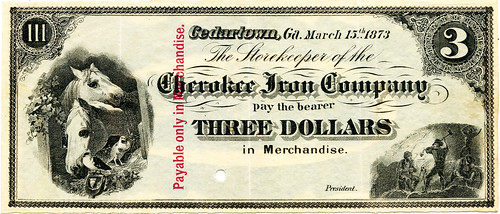
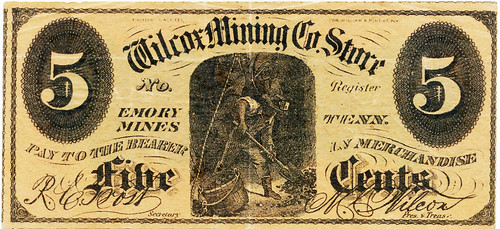
Yankee Robinson Quadruple Show Counterstamp
Dave Schenkman also shared this counterstamp he picked up in the recent Holabird sale. Thanks!
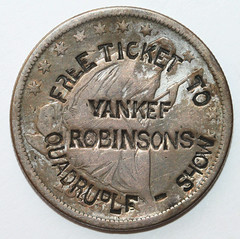
War of 1812 Congressional Medals
Chris Neuzil writes:
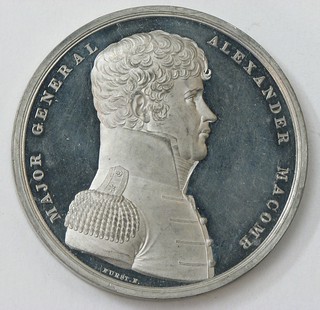 "I've been diving into die states of War of 1812 Congressional medals - originals and restrikes. Here's an example: the medal for Alexander Macomb for the
Battle of Plattsburgh (NY) in white metal struck in the late 1820s for the War Department (a few years after his gold medal), and a bronzed copper restrike probably dating to the late 19th century.
"I've been diving into die states of War of 1812 Congressional medals - originals and restrikes. Here's an example: the medal for Alexander Macomb for the
Battle of Plattsburgh (NY) in white metal struck in the late 1820s for the War Department (a few years after his gold medal), and a bronzed copper restrike probably dating to the late 19th century.
"The early die state of the white metal example shows that the finish of the original medals was what we now call a cameo proof, with frosted relief and mirror-like fields. This finish is also seen on surviving gold medals and well-preserved silver medals awarded by the Navy. Note the struck-through stray fiber debris below and left of FURST (Moritz Furst, the engraver).
"The later die state shows rust pits on the uniform jacket and extensive lapping to remove rust from the field - the high part of the die. The lapping nearly removed FURST.F., effaced parts of the uniform lapel, and made a gap between the point of the bust and the rim. There's also a new divot in the die below the bust forming a surprisingly regular circular raised dot.
"This and other dies of the series were paid for by the War or Navy Department but remained at the Mint and through the 19th century many rusted or were damaged by mishandling there. For perspective, the dies were hand-engraved and cost in the neighborhood of $500 each when most were made between about 1815 and 1825, and a Bureau of Labor Statistics inflater equates that to about $11,000 in 2020. But $500 was a livable annual income in 1820 so the real cost was arguably much more in today's dollars."
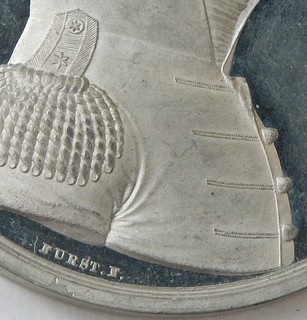
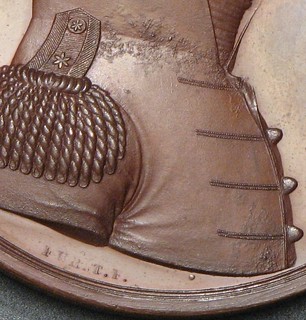
Robert Hoppensteadt writes:
"Those notes and the medals are very cool. I haven't been able to win anything new - a well known whale has been active and driven prices past my interest level."
Thanks, everyone. 'Til we meet again.... -Editor
NUMISMATIC NUGGETS: MAY 17, 2020
Here's a selection of interesting or unusual items I came across in the marketplace this week. Tell us what you think of some of these. -Editor
1792 Denmark End of Slave Trade Medal
This was in Shanna Schmidt's Newsletter #153. Great medal and history! -Editor
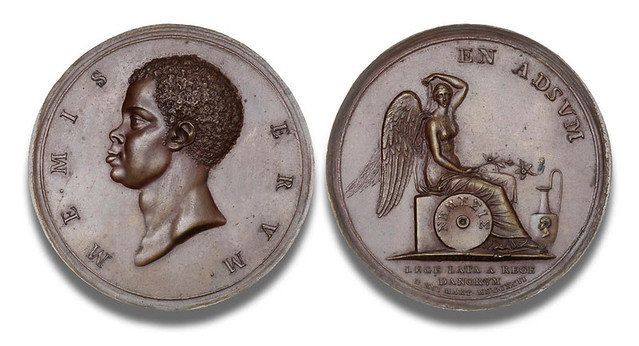
I'd love to tell everyone about a very fun purchase I made for a customer this past week. I normally don't do this (and I did get the approval of said customer) but this was just such an exciting buy that I want to share. I participated in the Bruun Rasmussen auction in Denmark a few days ago. There was an incredible selection of coins and medals from the Zinck collection. A majority of the collection had been sold and this was some of the remaining pieces.
Lot 496 caught my eye early on in the auction. It was a commemoration medal of the end of the Atlantic slave trade in 1792. Denmark was the first country to abolish the slave trade and this medal is an important indicator in the historical timeline. Although the official law abolishing slavery in Denmark did not occur until 1803, the 1792 Edict of Crown Prince Frederik VI was the first proverbial line in the sand. In January 2018 the Colonial Williamsburg museum acquired one of these exceedingly rare medals. Lot 496 came from a 1930 Copenhagen auction so this was in private hands for many years. Acquiring this medal was really one of the more exciting things I have done in awhile. I know my customer will likely share this medal in some powerful way in the future.
The latin phrase on the obverse "Me Miserum" ("Woe is me" or "Poor me") encircles a naturalistic portrait of an African slave. The reverse image shows the mythological winged goddess Nemesis, who was thought to be the avenging goddess of divine indignation against and retribution for evil deeds and undeserved good fortune. She is depicted seated and facing forward on a platform decorated with a shield that bears her name while holding an apple branch in one hand and touching her wing with the other. The Latin legends indicate the medal was produced under the Danish King's law and includes the date of the edict, March 16, 1792. (This last sentence was taken directly from Auction Daily News 2018).
To visit Shanna's web site, see:
https://www.shannaschmidt.com/
Rejoice Oh Young Man In Thy Youth Medal
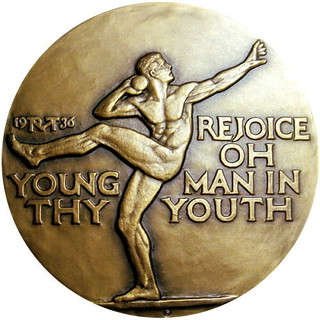
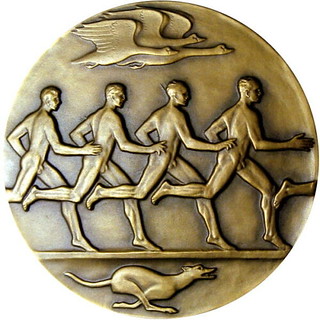
Society of Medalists medal number 13 from 1936 Bronze 73mm in very good condition with a mintage of just 1,001 by artist R. Tait McKenzie sculptor. Rejoice Oh Young Man In Thy Youth. With view nude male shot putter and runners. Buyer pays $3.95 postage. South Carolina residents add 8% sales tax.
This one is an eBay offering from Steve Hayden. Great medal! -Editor
To read the complete lot description, see:
1936 Society Of Medalists #13 Medal Olympic 73mm R Tait McKenzie
(https://www.ebay.com/itm/1936-Society-Of-Medalists-13-Medal-Olympic-73mm-R-Tait-McKenzie/383538208327)
1997 Framed Boggs $500 and $1000 Bills
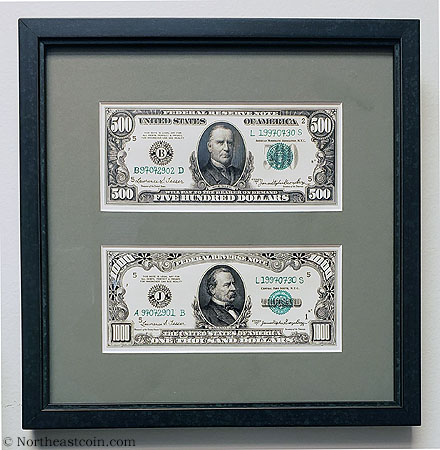
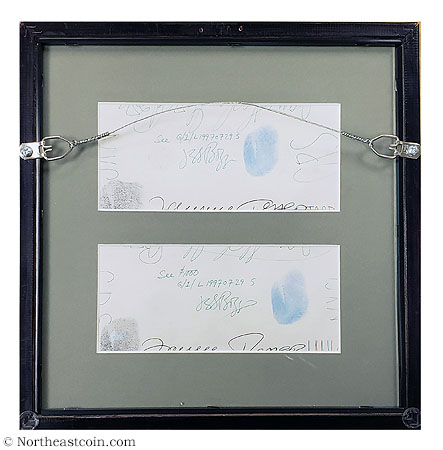
We are excited to offer a piece of numismatic and artistic legend. We have a framed set of $500 and $1000 Boggs Bills. James Stephen George Boggs' signature appears as Secretary of the Treasury on both bills. American Numismatic Association, N.Y.C. is printed on the $500. The back of both bills include Boggs' blue and black inked thumbprints alongside his signature as JSG Boggs. Boggs created works of art that closely resembled paper currency; he would then try to use them to pay for goods or services. He did not call his single sided works of art money, but he did place a value on them that matched their face value. It was then up to the potential recipient as to whether or not to accept the work of art as payment. Boggs was said to have used these two bills to pay for dental work. This is an opportunity to own two high denomination Boggs Bills used in a single transaction.
From the Northeast Numismatics site. The thumbprints are an anti-counterfeiting measure. -Editor
To read the complete item description, see:
Currency 1997 Boggs $500 and $1000 (https://www.northeastcoin.com/popupcontainer.jsp?include=vi&itemKey=zi34_12233230)

YEAR TWO BAR KOKHBA REVOLT COIN FOUND
Aaron Oppenheim passed along two articles about a recent find in Jerusalem's Old City. Arthur Shippee added one from The Jerusalem Post. Thanks. -Editor
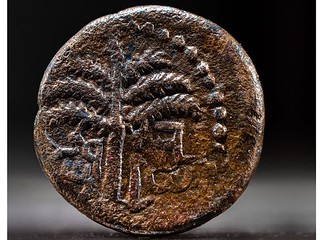 Israel's Antiquities Authority (IAA) has presented a rare coin from the Bar Kokhba Revolt period (132-135 CE), which was discovered during an archaeological excavation in
Jerusalem's Old City.
Israel's Antiquities Authority (IAA) has presented a rare coin from the Bar Kokhba Revolt period (132-135 CE), which was discovered during an archaeological excavation in
Jerusalem's Old City.
The IAA frequently reveals interesting finds from its sites from around the country ahead of Jewish holidays and festivals - and this is no different, the announcement coinciding with the celebration of Lag BaOmer (the 33rd day of the counting between the two pilgrim festivals of Passover and Feast of Weeks).
Found at the Davidson Archeological Park in Jerusalem's Old City Jewish Quarter between the Temple Mount and the City of David, the coin is decorated with a cluster of grapes and the inscription "Year Two of the Freedom of Israel" on the obverse side. On the other, there is a representation of a date palm, as well as the inscription "Jerusalem."
A find of this nature inside Jerusalem is very rare, although a large number of coins from the Bar Kochba period have been found at sites outside the capital. According to a Foreign Affairs Ministry press release, "Dr. Donald Tzvi Ariel, Head of the Coin Department at the Israel Antiquities Authority, examined over 22,000 coins discovered in archaeological excavations in the area of the Old City in Jerusalem. This examination revealed that only four of the coins are dated to the period of the Bar Kokhba revolt."
The Jewish rebellion broke out in response to Roman Emperor Hadrian's declaration of the establishment of a colony called "Aelia Capitolina." His provocative desire to build a pagan temple to the god Jupiter on the site of the now-destroyed Second Temple on the Temple Mount, coupled with decrees restricting Jewish worship was the spark that ignited the Jewish response.
To read the complete articles, see:
Rare coin dating nearly 2,000 years, discovered in Jerusalem's Old City
(https://www.i24news.tv/en/news/israel/israel/1589201003-israel-antiquities-authority-unveils-rare-coin-dating-nearly-2-000-years)
Rare coin from Bar-Kokhba revolt unearthed near the Temple Mount in Jerusalem (http://www.israelnationalnews.com/News/News.aspx/280026)
Ancient coin tied to Jewish rebellion against Romans found in Jerusalem
(https://www.jpost.com/israel-news/rare-1900-year-old-bar-kochba-coin-unveiled-ahead-of-lag-baomer-627638)
ADAMS FAMILY TETRADRACHM OF NERO AND POPPAEA
David Sundman passed along this article from the San Antonio Current about interesting items in the collections of San Antonio Museums. One featured item is an ancient Roman coin. -Editor
David writes:
"An interesting provenance for an interesting roman provincial coin that is very affordable."
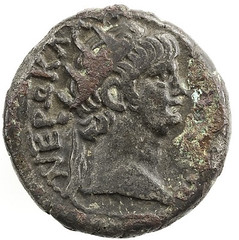
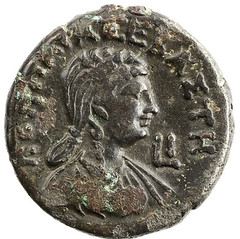
Tetradrachm of Nero and Poppaea, San Antonio Museum of Art Roman, A.D. 64–65, Billon, diam. 2.5 cm, San Antonio Museum of Art, gift of Gilbert M. Denman, Jr., 91.111.30.
There are plenty of ancient coins in SAMA's collection, but this one has a notable pedigree.
"This Roman coin from Alexandria, Egypt, bears a portrait of the emperor Nero on one side and his wife Poppaea on the other side. It's made of billon, a mixture of valuable silver with much cheaper copper or copper alloy," said Lynley McAlpine, a postdoctoral curatorial fellow at the museum.
"The coin itself is not that unusual but its history is special. This ancient coin was previously in the collection of the historian Henry Adams, who was the grandson of President John Quincy Adams, and the great-grandson of President John Adams.
"The Adams family coin collection was started by John Adams, added to by John Quincy Adams, and passed down to Henry Adams — but we don't know exactly who added this particular coin to the collection. Henry Adams donated the entire collection to the Massachusetts Historical Society in 1913.
"In the 1970s, when the Massachusetts Historical Society wanted to make microfilm copies of the Adams family papers, they sold the coin collection to raise money for that project. Eventually it made its way to San Antonio, and it's the only object from the Ancient Mediterranean collection that we know once belonged to a family of U.S. presidents."
To read the complete article, see:
Odd Objects: San Antonio Museums Share Fascinating (and Creepy) Finds From Deep in
Their Collections (https://www.sacurrent.com/ArtSlut/archives/2020/05/12/odd-objects-san-antonio-museums-share-fascinating-and-creepy-finds-from-deep-in-their-collections)
BROWNING PLATE 1823/2 QUARTER OFFERED
Numismatists have been researching the provenance and current whereabouts of prominent rarities for many years, and once in a while new connections are made, advancing our knowledge of coins and the people who collected them. Last week we mentioned Nathan Markowitz's recognition of a coin illustrated in the classic Browning reference on U.S. quarter dollars. The piece will appear in the Stack's Bowers June 2020 sale. Senior Numismatist and Consignment Director James McCartney wrote a blog article on the piece. -Editor
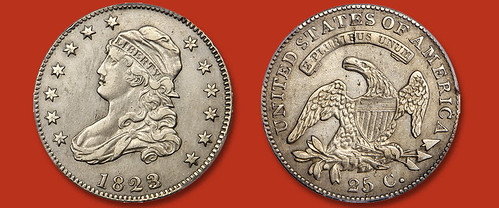
?Few American rarities have been so carefully documented and studied for provenance as the 1823/2 Capped Bust quarters. The rarity of this date was already legendary by the time Montroville W. Dickeson wrote his 1859 American Numismatical Manual, where he pronounced this date "extremely rare." In 1883, Harold P. Newlin posited that the four rarest U.S. silver coins were the 1802 half dime, the quarters of 1823 (all of which are 1823/2) and 1827, and the 1804 dollar, helping to contextualize the truly elusive nature of this issue.
Thirty-one discrete specimens have been documented, and a few more are assumed to exist in old-time collections or unexamined institutional holdings, yielding about 35. The Smithsonian Institution and the Durham Western Heritage Museum in Omaha both own well-worn specimens. More than half of the known survivors are in grades below Very Fine, most quite worn, a few damaged, even one famously repaired to remove graffiti.
Featured in our June 2020 Santa Ana Auction is an EF-45 (PCGS) 1823/2 quarter that is appearing on the market for the first time in over 85 years. The obverse is pearly silver-gray with a dusting of pinkish-bronze near the borders. It is uniformly sharp with full denticles at the rim and centrils visible on every star. A minor blemish at the edge between stars 5 and 6 serves as a pedigree marker. The reverse is evenly toned in peach and golden iridescence, with hints of pearly luster in the fields surrounding the eagle. Trivial mint-made planchet streaks show around the eagle's head including a prominent streak through the B of PLURIBUS, and will help with pedigree tracing.
The present coin is very significant in the context of this incredibly rare issue. It was ranked as CC#8 in the exhaustive 2010 census by Rory Rea, et al., with an estimated grade of EF-40. At the current grade of EF-45 (PCGS), it is tied as the fourth finest certified by PCGS, with the AU-58+ Brand-Gardner-Link coin at the top of this population. No examples are currently graded in Mint State by PCGS or NGC, and the Newcomer-Miles-Hawn specimen has been graded Proof-64 (PCGS).
This piece was illustrated as a plate coin in the seminal 1925 reference The Early Quarter Dollars of the United States 1796-1838 by Ard W. Browning. It can be traced back to George S. Seavey circa 1873, and next it appeared in the legendary June 1890 sale of the Lorin G. Parmelee Collection. Plated in lot 947 and sold for $132, it was described as "excelled by only one specimen" and "exceedingly rare." It then appeared a few times in the early 20th century, first at the January 1914 ANS Exhibit and then in in the Waldo C. Newcomer Collection, as advertised by B. Max Mehl in the March 1932 issues of The Numismatist. It last appeared publicly over 85 years ago in Louis R. Hemmer's Premium List of May 1935 and has been held privately since. While not technically a "new" discovery, this offering is certainly an exciting re-discovery from the early quarter series.
This historic EF-45 (PCGS) 1823/2 quarter will be sold in our June 18-19, 2020 Santa Ana Auction, offered alongside Vermont coppers from the Q. David Bowers Collection, the Francesca Collection of US Gold Coins, The Dazzling Rarities Collection, and many other rarities. The sale will be available for bidding and viewing on our website www.StacksBowers.com or you may contact us to secure a copy of the printed catalog.
To read the complete article, see:
Historic Browning Plate 1823/2 Quarter Featured in our June 2020 Auction
(https://www.stacksbowers.com/News/Pages/Blogs.aspx?ArticleID=1823-overdate-capped-bust-quarter)
To read earlier E-Sylum articles, see:
HAZELTINE CHUBBOCK SALE PRL SOUGHT (https://www.coinbooks.org/esylum_v09n52a07.html)
QUERY: WHERE IS THE HAINES 1823/2 QUARTER? (https://www.coinbooks.org/esylum_v14n03a10.html)
NUMISMATIC NUGGETS: MAY 10, 2020 : 1823/2 Quarter (https://www.coinbooks.org/v23/esylum_v23n19a23.html)
EARLY COPPER COINAGE OF LIBERIA
Although I've never collected them, I've always been attracted to the coins of Liberia and fascinated with the country's history and ties to the U.S. Stack's Bowers Senior Numismatist and Cataloger Jeremy Bostwick published a blog article on Liberia's early coppers. -Editor
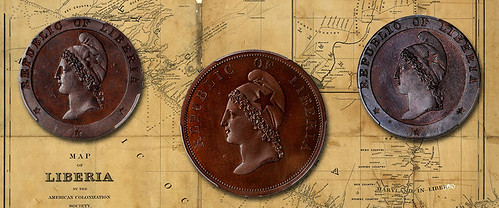
Though legal slavery would continue through the Civil War, the number of manumitted slaves, as well as their descendents, had become sizable enough by the early 19th century that those both for and against America's peculiar institution found merit in the establishment of a free state in Africa as a home to these freedmen. For those against slavery, it was understood that racism, even in free states, would likely hamper liberated African Americans' pursuit of their inalienable rights. For those in favor of slavery, the idea of freedmen assisting their enslaved brethren—be it by escape or revolt—was at the forefront of concern. As such, when the American Colonization Society was founded in 1816 with the goal of establishing a homeland in Africa for freed slaves and their families, it was met with support from both sides.
The African Americans who would be uprooted in this endeavor, however, were not overly enthusiastic. Despite the many pitfalls and hardships that they had faced—and would likely continue to face—in America, it was their homeland, and the idea of emigrating was not very popular. Nevertheless, volunteers began establishing what would become Liberia in 1822 on the West African "Pepper Coast." Over the next 25 years, more than 4,000 settlers would arrive in this new land, though disease would ultimately cut this number in half. In 1847, independence was declared, with the United Kingdom being the first nation to recognize the sovereignty of Liberia. The United States, owing to the influence of many pro-slavery southerners, did not grant recognition until 1862 following the secession of such opponents.
Switching the focus to numismatics, the Liberian dollar was introduced in the same year that independence was declared, with its value being pegged to that of the U.S. dollar. This allowed for American currency to circulate and be exchanged as a de facto local coinage. There were, however, small steps taken at a proper, national coinage in 1847 and later in 1862, with one and two cent copper coins (as well as their respective pattern issues) struck.
Though the reverses of these types feature a palm tree on a coastline along with a ship visible at a distance, the indigenous flair stops there. The obverse designs, varying only slightly between the pattern and circulation strikes, instead point toward the neoclassical themes that were found on contemporaneous western European coinages like those of France. The concept of Liberty herself is represented by a left facing female bust wearing a Phrygian cap. Similar to the way in which the colony was created—from the minds of white businessmen and politicians and not from those of the freed slaves and their families—the coinage too was created through a somewhat elite, Caucasian lens.
Our upcoming Collectors Choice Online (CCO) auction in June will present a generous offering of one and two cent coins of Liberia, along with a few patterns, nearly all of which verge on Gem quality and display rich, vibrant surfaces and radiating luster. Look for these interesting and desirable specimens on our website in the coming weeks!
To read the complete article, see:
Liberia's Early Coppers — A Neoclassical Ideal
(https://www.stacksbowers.com/News/Pages/Blogs.aspx?ArticleID=patterns-of-liberia-world-cco)
SILVER DOLLARS IN NEVADA CASINOS
Nevada author and historian Dennis Cassinelli published an article this weekend in the Nevada Appeal about the use of silver dollars in Nevada Casinos. -Editor
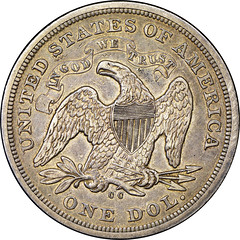 My mother, Phyllis, was one of the first female blackjack dealers in Nevada. She and her sister, Clare, worked for Harold's Club in Reno in the early 1940s. General Manager Raymond "Pappy" Smith was the first Nevada
casino owner to hire female blackjack dealers to work in the clubs. His reasoning was, if casinos hired female dealers, more GIs from the Reno Army Airbase would be attracted to the clubs. In modern times, female dealers are common.
My mother, Phyllis, was one of the first female blackjack dealers in Nevada. She and her sister, Clare, worked for Harold's Club in Reno in the early 1940s. General Manager Raymond "Pappy" Smith was the first Nevada
casino owner to hire female blackjack dealers to work in the clubs. His reasoning was, if casinos hired female dealers, more GIs from the Reno Army Airbase would be attracted to the clubs. In modern times, female dealers are common.
In those days, casinos used composite chips nearly as much as they do today. However, they also used the common medium of exchange in Nevada at that time, the silver dollar, for many of their table games. Winners were paid out in silver dollars as were tips and even sometimes wages.
When I started school in Sparks, hot lunch was 20 cents per day or $1 for the whole week. Every Monday, Mom, being a blackjack dealer, would give me one silver dollar from her tip money for my weekly lunch. I soon noticed in addition to the Peace dollars minted from 1921 through 1935, most were the much older Morgan dollars minted off and on from 1878 through 1904 and again in 1921.
I was fascinated so many of the silver dollars given to me for lunch money were made back in the 1800s. One day, I noticed to my surprise that one of the silver dollars she gave me was a Carson City silver dollar dated 1890. I went all week without lunch and kept the old Carson City silver dollar. I can honestly say I still have the first dollar I ever saved. Since then, I have found or acquired several more. Silver dollars make great gifts to grand children.
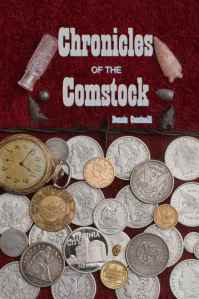 In 1999, my crew and I uncovered the amazing stash of over 500 coin dies that had been buried in the ground at the Nevada State Museum, formerly a branch of the U.S. Mint. Many of these dies were used to strike
the Carson City silver dollars and Trade Dollars. Some of these rusted dies have been cleaned and displayed at the museum. I believe that were it not for my fascination for silver dollars, the buried coin dies would not have even been noticed by my
employees. On the cover of my book, Chronicles of the Comstock, are color photos of several of my Carson City silver dollars, including the one given to me by Mom for lunch money and an unusual Carson City Trade dollar. The book has many
stories about the Comstock era and the historic old mint. At the museum, you can see the coin press where the coins were struck, along with a display of nearly every gold and silver coin ever produced there. Chronicles of the Comstock makes an
excellent gift for people interested in Nevada History.
In 1999, my crew and I uncovered the amazing stash of over 500 coin dies that had been buried in the ground at the Nevada State Museum, formerly a branch of the U.S. Mint. Many of these dies were used to strike
the Carson City silver dollars and Trade Dollars. Some of these rusted dies have been cleaned and displayed at the museum. I believe that were it not for my fascination for silver dollars, the buried coin dies would not have even been noticed by my
employees. On the cover of my book, Chronicles of the Comstock, are color photos of several of my Carson City silver dollars, including the one given to me by Mom for lunch money and an unusual Carson City Trade dollar. The book has many
stories about the Comstock era and the historic old mint. At the museum, you can see the coin press where the coins were struck, along with a display of nearly every gold and silver coin ever produced there. Chronicles of the Comstock makes an
excellent gift for people interested in Nevada History.
To read the complete article, see:
Dennis Cassinelli: My fascination for silver dollars
(https://www.nevadaappeal.com/news/opinion/dennis-cassinelli-my-fascination-for-silver-dollars/)
To read the earlier E-Sylum article, see:
ARTICLE HIGHLIGHTS HISTORIC COIN PRESS NO. 1 (https://www.coinbooks.org/v20/esylum_v20n27a14.html)
MALTA'S ILLUMINATED LETTER COINS
Ultramodern numismatist Pabitra Saha passed along this article about Malta's new multicolored coins depicting illuminated letters from a classic medieval manuscript. Thanks. Perfect combination for the numismatic bibliophile! -Editor
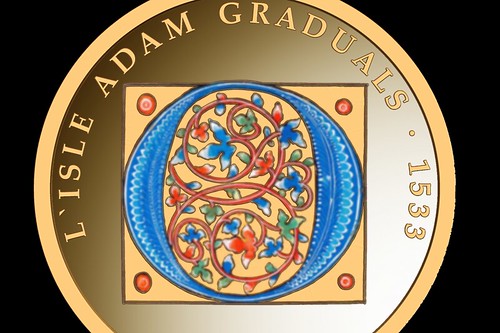
The Central Bank of Malta has issued numismatic coins in gold and silver depicting an illuminated letter from the L'Isle Adam Graduals. The coins form part of the Europa program with the theme 'Gothic' and bear the Europa Star logo.
The gold coin has a face value of €50 and the silver coin of €10. The €10 coins, which will be limited to 2,500 pieces, will be struck in 0.925 silver. Each coin has a weight of 28.28g and a diameter of 38.61mm.
The €50 coins will be limited to 400 pieces, each struck in 0.916 gold, weighing 6.5g and having a diameter of 21mm. Both the silver and the gold coins are finished to proof quality. The gold coin will be sold for €350, while the silver coin will be sold for €65.
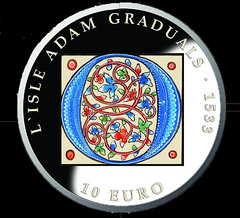 The coins were designed and minted by the Royal Dutch Mint. The obverse of the coin features the coat of arms of Malta and the Europa Star logo. The reverse of the coins
depicts an illuminated letter O found in the L'Isle Adam Graduals, which are housed in the museum of St John's Co-Cathedral. Colour printing techniques have been used on the coins to reproduce the chromatic and aesthetic qualities of the original
artwork.
The coins were designed and minted by the Royal Dutch Mint. The obverse of the coin features the coat of arms of Malta and the Europa Star logo. The reverse of the coins
depicts an illuminated letter O found in the L'Isle Adam Graduals, which are housed in the museum of St John's Co-Cathedral. Colour printing techniques have been used on the coins to reproduce the chromatic and aesthetic qualities of the original
artwork.
The Central Bank of Malta acknowledged the consent given by St John's Co-Cathedral Foundation to reproduce this artwork on the coins.
The L'Isle Adam Graduals, which date to around 1533, are considered to be Malta's finest illuminated manuscripts. They consist of a set of 10 choir books commissioned from a French scriptorium by Grand Master Philippe Villiers de L'Isle Adam.
These graduals were produced quite some time after the advent of printing, epitomised by the Gutenberg Bible of 1455. This reflects the complexity of printing music scores, which ensured that the production of manuscript choir books – largely using medieval techniques – survived into the 16th century.
To read the complete article, see:
Polychromatic coins depicting illuminated letter issued by Central Bank
(https://timesofmalta.com/articles/view/polychromatic-coins-depicting-illuminated-letter-issued-by-central.790814)
HORSERACING TICKETS AND PASSES
Dix Noonan Webb is offering an interesting group of horseracing tickets and passes in their may 26, 2020 Tokens and Historical Medals sale. Here's the press release. -Editor
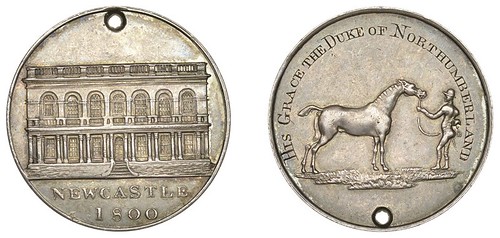
International coins, medals, banknotes and jewellery specialists Dix Noonan Webb, are encouraging racing enthusiasts to take a gamble on a group of 18th and 19th century horse racing tickets and passes that will be offered in a live online auction in their sale of Tokens and Historical Medals on Tuesday, May 26, 2020 at 11am on their website www.DNW.co.uk
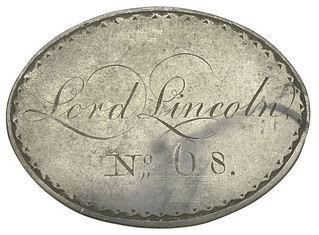 The collection comprises 20 lots and estimates range from £40 to £400. Many of the pieces are engraved with names of nobility and well-known figures in the horseracing fraternity such as the Duke of Northumberland (Alnwick
Castle); Hon. Egremont Lascelles (Harewood House); Major John St Leger; Henry Fiennes Pelham Clinton, (2nd Duke of Newcastle); the Duke of Portland and Lord Dundas.
The collection comprises 20 lots and estimates range from £40 to £400. Many of the pieces are engraved with names of nobility and well-known figures in the horseracing fraternity such as the Duke of Northumberland (Alnwick
Castle); Hon. Egremont Lascelles (Harewood House); Major John St Leger; Henry Fiennes Pelham Clinton, (2nd Duke of Newcastle); the Duke of Portland and Lord Dundas.
As Peter Preston-Morley, Specialist and Associate Director, Dix Noonan Webb, commented: "We are very pleased to be offering this fascinating group of early tokens relating to horseracing – right now, when there's no racing taking place, it is a perfect opportunity to take a gamble on these!"
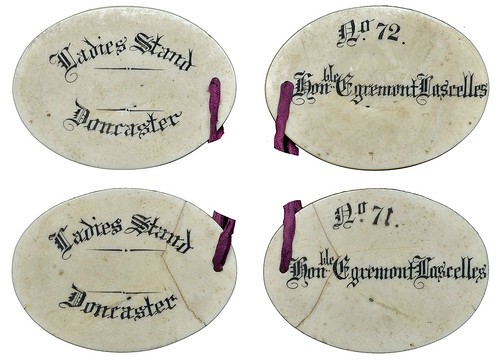
The collection, from several different owners, includes pieces dating from throughout the 18th and 19th centuries. Among the highlights is a very rare silver example depicting the Newcastle Grand Stand that belonged to His Grace the Duke of Northumberland. Lt-General Hugh Percy, 2nd Duke of Northumberland (1742-1817), acceded to the title in 1786, and after an illustrious military career, in later life, he became one of the richest men in England (estimate: £300-400). There is a pair of ivory admission tokens to the Ladies Stand at Doncaster bearing the name Honble. Egremont Lascelles. Lascelles, who lived at Harewood, was a prominent figure at race meetings in Yorkshire from the late 1840s until the late 1870s and his pair of tokens, for him and his wife, is estimated at £300-400.
Other Racecourses featured include Nottingham, Newmarket, Richmond, Ripon, Long Marston, York and Leeds.
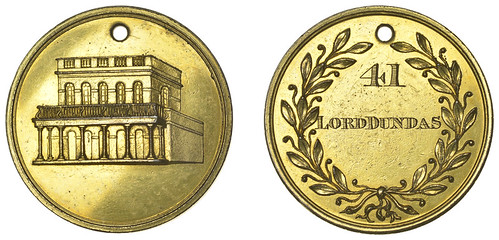
PENTAGON HOARD $20 MISMATCHED SERIAL NUMBERS
Northeast Numismatics is offering an interesting error note hoard - here's the description from their email announcement. I have a small collection of error notes myself, mostly dollars. Nice find. -Editor
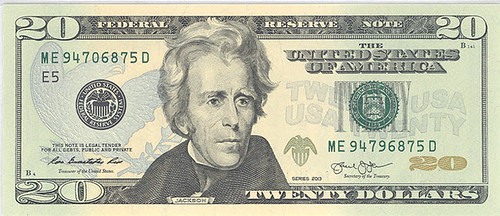
Some of you may recall an email we sent out last year announcing a group of currency errors that we had obtained. As with the rest of us, the fine folks at the Bureau of Engraving and Printing have their off days. One of those off days lead to what we are now offering - a group of $20 notes that have mismatched serial numbers!
These particular notes came from what we affectionately call The Pentagon Hoard. Someone contacted us about a run of notes they had recently obtained from an ATM machine inside the Pentagon. This particular employee had a mind for numbers, and impressively recognized that the serial numbers on some of the $20's he received from the machine were mismatching. He contacted a colleague of his and they descended back upon the ATM machine to see if there were more. Sure enough, they were able to withdraw approximately 50 notes before the serial numbers started matching again.
We are offering them all together for the first time, with grades ranging from 64 EPQ up to 68 EPQ. You'll find them listed in the currency section on our website. Not into the mistakes of the B.E.P. or currency in general? No problem, even through all that is currently going on, we've been adding plenty of new coins to our inventory.
We hope that all of you are doing well and staying safe!
P.S. Working remotely has allowed us more time to post to our blog. Be sure to check it out.
To browse their inventory, see:
Selected Inventory (https://www.northeastcoin.com/inventory.jsp)
To read the Northeast Numismatics blog, see:
Northeast's Blog (https://www.northeastcoin.com/blog.jsp)
To sign up for their email list, see:
Emailing List (https://www.northeastcoin.com/mailingList.jsp?pageAction=new)
WHAT IF PALESTINE HAD ITS OWN CURRENCY?
This is an article from 2019 that I discovered recently. It's always interesting to see how artists envision new designs for currency - or in this case, a design for an entirely new currency for Palestine. See the complete article online for all of the designs. -Editor
Designer Jehad Naji, 29... had the idea of designing a currency for Palestine after a British journalist asked him about which currency to use during a visit to Gaza. Naji had to explain to him that there was none and that Palestinians have to use the Israeli shekel.
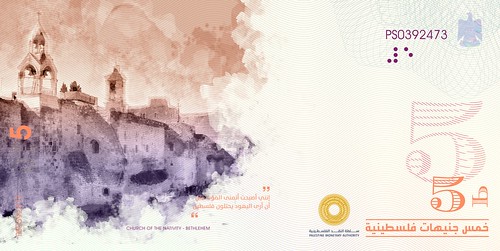
"People living outside Palestine have no clue that being occupied means that you do not get to decide even on your own currency," Naji says. Here, his design for the front of the five-pound note shows the Church of the Nativity in Bethlehem (all note designs copyright Jehad Naji).
Naji says the hardest part was choosing which Palestinian figures and landmarks to use. The back of the five-pound note features Abdul Qader al-Hussaini, the commander and key founder of the Army of the Holy Jihad (Jaysh al-Jihad al-Muqaddas) in the 1947-48 war. "Although at first I decided to reflect only the Palestinian culture in the currency, [but] I could not ignore Abdul Qader al-Hussaini," he says. "No one can deny the role of the Islamic trend in Palestine."
Palestinians used the Palestinian pound during the British Mandate of Palestine (1927-1948), after which no further notes were issued. In Gaza, the Egyptian pound was used from 1951, while in the West Bank the Jordanian dinar was used from 1952. The shekel has been used in both territories since the 1967 occupation. The front of the ten-pound note, above, shows the Ibrahimi Mosque in Hebron.
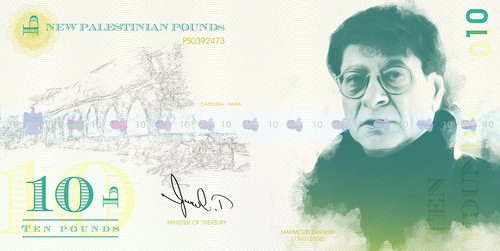
Naji's wife, Haneen Abu Samhadana, supported him during the 13-month project, advising and helping choose colours. "The greatest shock was after we posted the photos, when we discovered that people abroad did not even know we use Israeli shekels and not our own currency," she says. The Palestinian poet Mahmoud Darwish is shown on the reverse of the ten-pound note, next to the Roman site of Caesarea in Haifa.
Naji says that when he had the designs made, the printer at the stationary shop was mesmerised. "I asked him which he preferred, the Israeli shekels or these Palestinian pounds. He said the Palestinian, without hesitation. People still have hope, they feel proud about anything that reminds them of their history." The back of the 20-pound note depicts the cartoonist Naji al-Ali, next to Lake Tiberias.
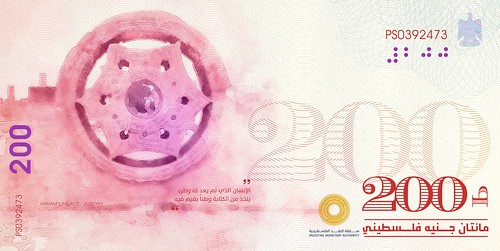
Naji's design for the front of the 200-pound note depicts Hisham's Palace in Jericho. While Naji and others want Palestine to have its own currency, the Palestinian Monetary Authority (PMA) told MEE that it would need to be in line with agreements that stipulate the approval of Israel, the World Bank and the IMF.
To read the complete article, see:
In pictures: What if Palestine had its own currency?
(https://www.middleeasteye.net/discover/pictures-what-if-palestine-use-own-currency-money)
LOOSE CHANGE: MAY 17, 2020
Here are some additional items in the media this week that may be of interest. -Editor
Coins of Medieval Hungary: Part II
On CoinWeek Mike Markowitz published the second part of his well-researched series on the medieval royal coinage of Hungary. -Editor
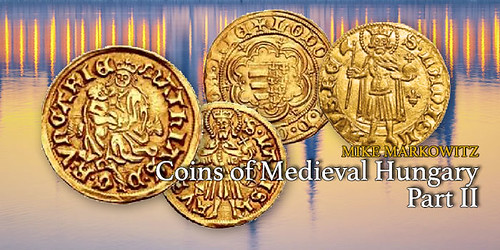
To read the complete article, see:
Coins of Medieval Hungary: Part 2 (https://coinweek.com/world-coins/coins-of-medieval-hungary-part-2/)
To read the earlier E-Sylum article, see:
LOOSE CHANGE: MAY 3, 2020 : Coins of Medieval Hungary: Part I (https://www.coinbooks.org/v23/esylum_v23n18a32.html)
Opening the 1795 Boston Time Capsule
Peter Huntoon passed along this video about the 2015 opening of a Boston time capsule from 1795. Thanks. -Editor
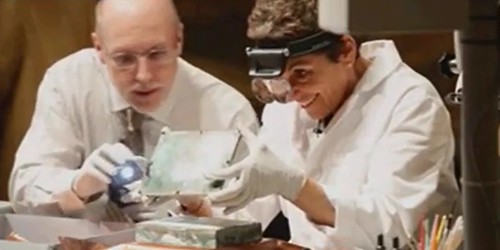

To watch the video, see:
Scientists open oldest US time capsule dating back to 1795
(https://www.msn.com/en-us/video/science/scientists-open-oldest-us-time-capsule-dating-back-to-1795/vi-BB142gPS)
To read earlier E-Sylum articles, see:
http://www.coinbooks.org/esylum_v17n51a12.html (1795 MASSACHUSETTS STATE HOUSE TIME CAPSULE)
BOSTON TIME CAPSULE OPENED (http://www.coinbooks.org/esylum_v18n02a08.html)
MASSACHUSETTS STATE HOUSE TIME CAPSULE EXHIBIT (http://www.coinbooks.org/esylum_v18n12a09.html)
Colin Narbeth (1929-2020)
CoinsWeekly published an obituary of dealer and banknote pioneer Colin Narbeth. -Editor
To read the complete article, see:
Colin Narbeth (1929-2020) (https://coinsweekly.com/colin-narbeth-1929-2020/)
To read the earlier E-Sylum article, see:
COLIN NARBETH (1929-2020) (https://www.coinbooks.org/v23/esylum_v23n19a09.html)
Harry Potter Books Found in Trash
Bibliophiles dream of finds like this - Harry Potter First Editions in the trash pile. -Editor
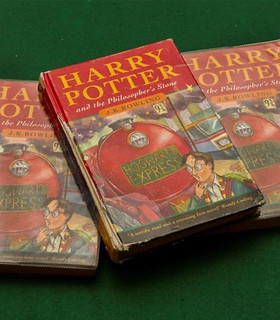 Three first edition Harry Potter books would have been lost in landfill if not for the actions of a Buckinghamshire school teacher. The teacher, who wishes to remain anonymous, spotted the books
in a trash bin where she worked in 2008 and couldn't bear to see them go to waste. Now they are expected to bring thousands at auction.
Three first edition Harry Potter books would have been lost in landfill if not for the actions of a Buckinghamshire school teacher. The teacher, who wishes to remain anonymous, spotted the books
in a trash bin where she worked in 2008 and couldn't bear to see them go to waste. Now they are expected to bring thousands at auction.
After the seller rescued the books, she kept them in her loft, but four years ago her son investigated their value. "A London business offered £4,000 for one of the paperbacks there and then, but they just went back into the loft," the seller said.
The seller then consigned two paperback versions of Harry Potter and Philosopher's Stone and one hardback, which are now going up for auction at Hansons Auctioneers and Valuers in a bumper Harry Potter-themed Library Auction on 21 May. The hardback is expected to sell for between £8,000 and £12,000 ($10,000-15,000), and the two paperbacks are expected to fetch £2,000 ($2,450) and £3,000 ($3,600) each.
There were 500 hardback first editions of Harry Potter and the Philosopher's Stone printed in 1997, which is when Harry Potter made his debut. 300 of the books were sent to British schools and libraries and others were sent to private book shops. All of them contain printing errors, which were corrected in later versions.
To read the complete article, see:
Rare Harry Potter Books Found in Trash at Auction (https://www.barnebys.com/blog/rare-harry-potter-books-found-in-skip-at-auction)
ROYAL MINT COIN SCULPTURES
Dennis Forgue writes:
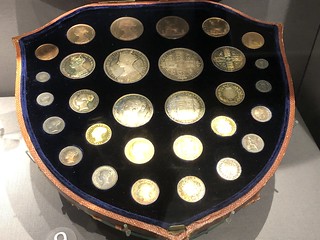 "The photo of the coin floor reminded me of of visit last October to the British Royal Mint in Llantrisant, Wales. Went to visit my cousins, and they obtained tour tickets. The Mint has been
open since 1974 but only started giving tours in 2016. Fantastic tour, got to strike my own 50p.
"The photo of the coin floor reminded me of of visit last October to the British Royal Mint in Llantrisant, Wales. Went to visit my cousins, and they obtained tour tickets. The Mint has been
open since 1974 but only started giving tours in 2016. Fantastic tour, got to strike my own 50p.
"Nice gift shop with all kinds of sets and real collector coins such as a Victorian gold 2 pound coin. It was hard to photo through glass but the cased double Victorian Proof set farthing to one pound using Young Head and Gothic portraits was fantastic. Photos in the Mint were not allowed, and you had to get through a metal detector to get inside with a small group.
"In the lobby was the Beatles "Penny Lane " car and the cartoon dog Gromit were made of "Pennies". Next to Gromit you can see a sign where the Mint offers Safety Deposit Boxes! Not exactly on the beaten path but worth a visit."
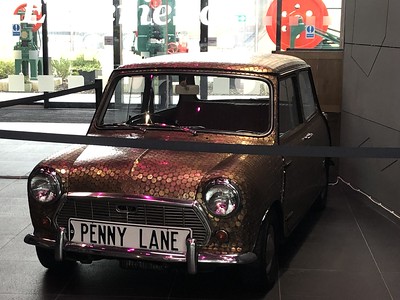
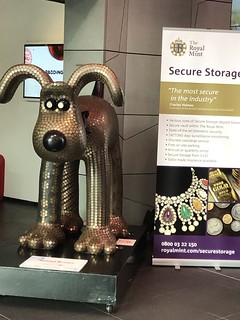
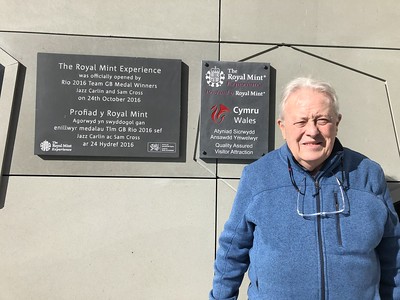
Dennis at the Mint
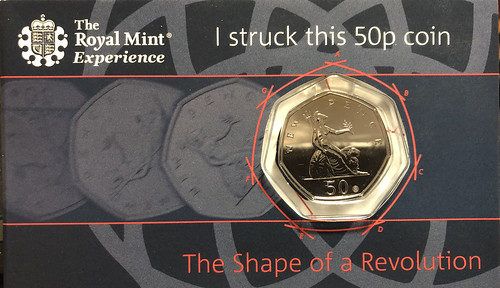
This is the 50 pence coin Dennis struck at the mint
Thanks! I'd love to visit someday. -Editor
To visit the Royal Mint web site, see:
https://www.royalmint.com/
To read the earlier E-Sylum article, see:
HOUSE BEAUTIFUL ON PENNY FLOORS (https://www.coinbooks.org/v23/esylum_v23n19a42.html)

